1. Spring MVC 获取三个域(request请求域,session 会话域,application 应用域)对象的方式
@
- 1. Spring MVC 获取三个域(request请求域,session 会话域,application 应用域)对象的方式
- 2. Servlet中的三个域对象
- 3. 准备工作
- 4. Spring MVC 获取 request 请求域对象的五种方式
- 4.1 第一种方式:使用原生Servlet API方式 获取到 request 请求域,同时获取到请求域当中对应的内容
- 4.2 第二种方式:使用 Model 接口 获取到 request 请求域,同时获取到请求域当中对应的内容
- 4.3 第三种方式:使用Map接口 获取到 request 请求域,同时获取到请求域当中对应的内容
- 4.4 第四种方式:使用 ModelMap 类 获取到 request 请求域,同时获取到请求域当中对应的内容
- 4.5 补充:Model、Map、ModelMap的关系
- 4.6 第五种方式:使用 ModelAndView 类获取到 request 请求域,同时获取到请求域当中对应的内容
- 4.7 补充:ModelAndView 源码分析
- 5. Spring MVC 获取 session 会话域对象的二种方式
- 6. Spring MVC 获取 application 应用域对象的方式
- 7. 总结:
- 8. 最后:
2. Servlet中的三个域对象
Servlet 中的三个域对象分别是:
请求域:request
会话域:session
应用域:application
三个域都有以下三个方法:
// 向域中存储数据
void setAttribute(String name, Object obj);
// 从域中读取数据
Object getAttribute(String name);
// 删除域中的数据
void removeAttribute(String name);
主要是通过:setAttribute + getAttribute 方法来完成在域中数据的传递和共享。
request:
接口名:HttpServletRequest
简称:request
request对象代表了一次请求。一次请求一个request。使用请求域的业务场景:
在A资源中通过转发的方式跳转到B资源,因为是转发,因此从A到B是一次请求,如果想让A资源和B资源共享同一个数据,可以将数据存储到request域中。
session:
接口名:HttpSession
简称:session
session对象代表了一次会话。从打开浏览器开始访问,到最终浏览器关闭,这是一次完整的会话。每个会话session对象都对应一个JSESSIONID,而JSESSIONID生成后以cookie的方式存储在浏览器客户端。浏览器关闭,JSESSIONID失效,会话结束。使用会话域的业务场景:
- 在 A 资源中通过重定向(重定向是一次新的请求)的方式转到 B 资源,因为是重定向,因此从 A到 B 是两次请求,如果想让 A 资源和 B 资源共享同一个数据,可以将数据存储到 session域中
- 登录成功后保存用户的登录状态
application
接口名:ServletContext
简称:application
application对象代表了整个 web 应用,服务器启动的创建,服务器关闭时销毁,对于一个 web 应用来说,application 对象只有一个。使用应用域的业务场景:记录网站的在线人数。
3. 准备工作
3.1 创建模块,添加依赖
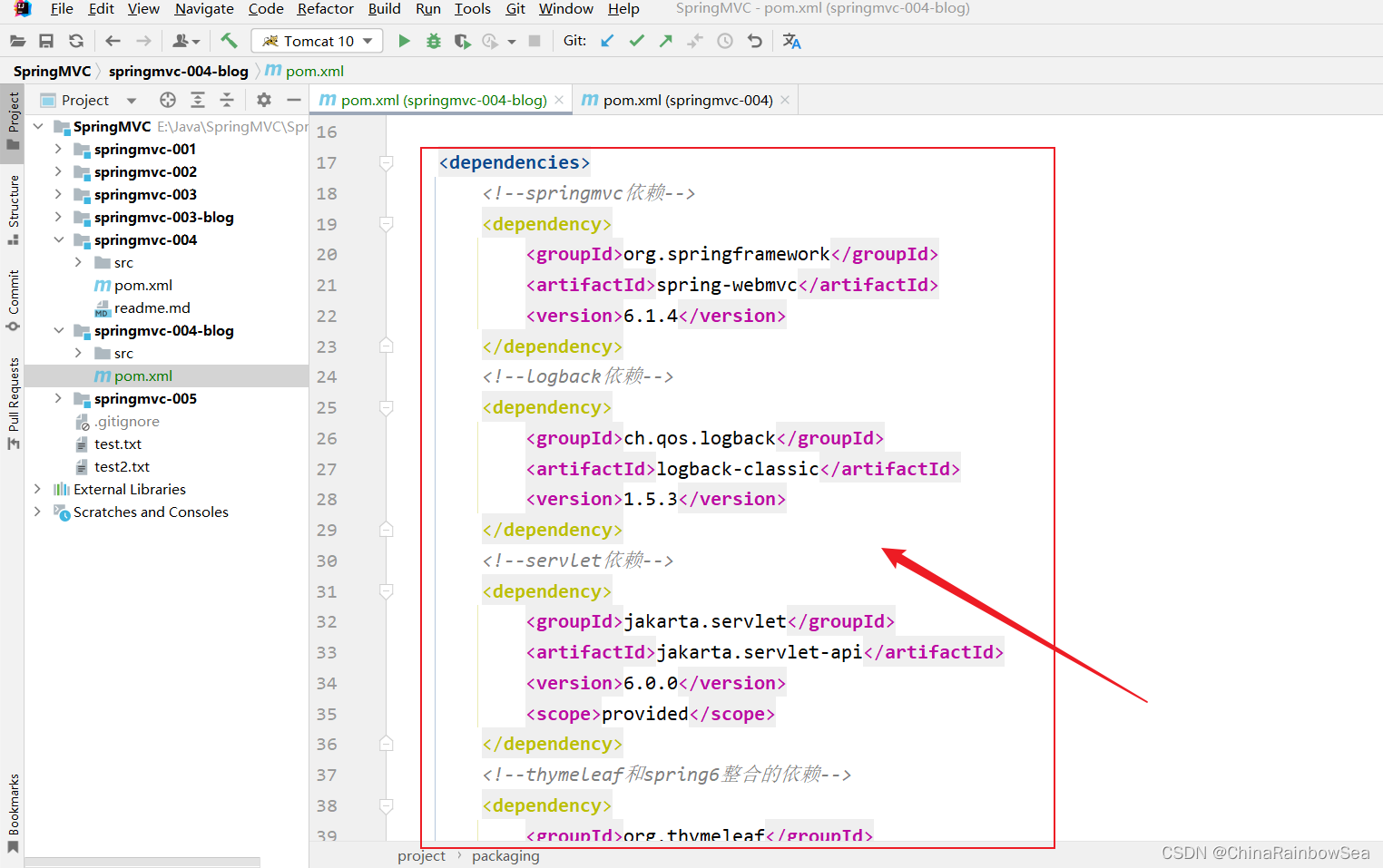
<project xmlns="http://maven.apache.org/POM/4.0.0"
xmlns:xsi="http://www.w3.org/2001/XMLSchema-instance"
xsi:schemaLocation="http://maven.apache.org/POM/4.0.0 http://maven.apache.org/xsd/maven-4.0.0.xsd">
<modelVersion>4.0.0modelVersion>
<groupId>com.rainbowseagroupId>
<artifactId>springmvc-004-blogartifactId>
<version>1.0-SNAPSHOTversion>
<packaging>warpackaging>
<properties>
<maven.compiler.source>17maven.compiler.source>
<maven.compiler.target>17maven.compiler.target>
properties>
<dependencies>
<dependency>
<groupId>org.springframeworkgroupId>
<artifactId>spring-webmvcartifactId>
<version>6.1.4version>
dependency>
<dependency>
<groupId>ch.qos.logbackgroupId>
<artifactId>logback-classicartifactId>
<version>1.5.3version>
dependency>
<dependency>
<groupId>jakarta.servletgroupId>
<artifactId>jakarta.servlet-apiartifactId>
<version>6.0.0version>
<scope>providedscope>
dependency>
<dependency>
<groupId>org.thymeleafgroupId>
<artifactId>thymeleaf-spring6artifactId>
<version>3.1.2.RELEASEversion>
dependency>
dependencies>
project>
3.2 添加 web 支持
先在 main 目录下,添加名为 webapp 的目录(文件夹),只能是这个 webapp 目录名,不可以是其他的。
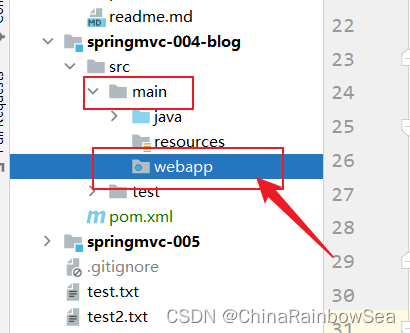
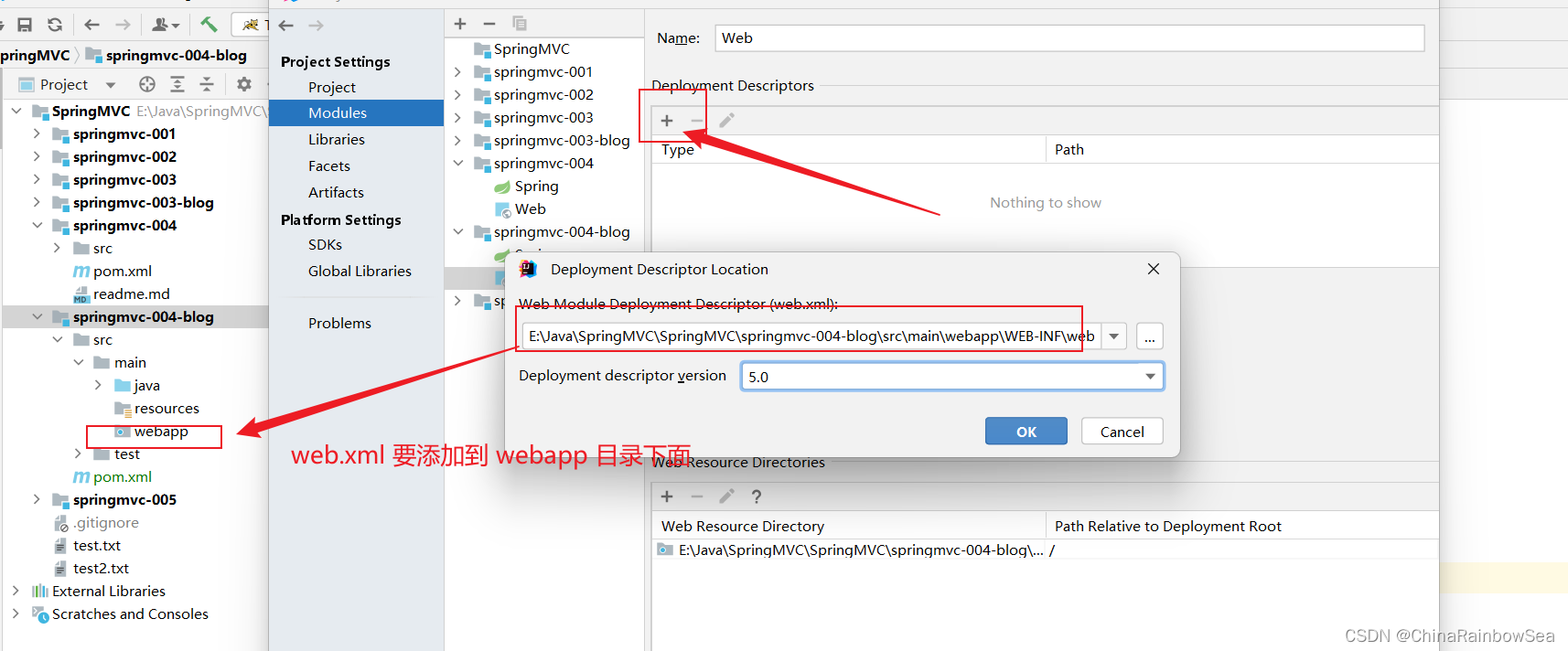
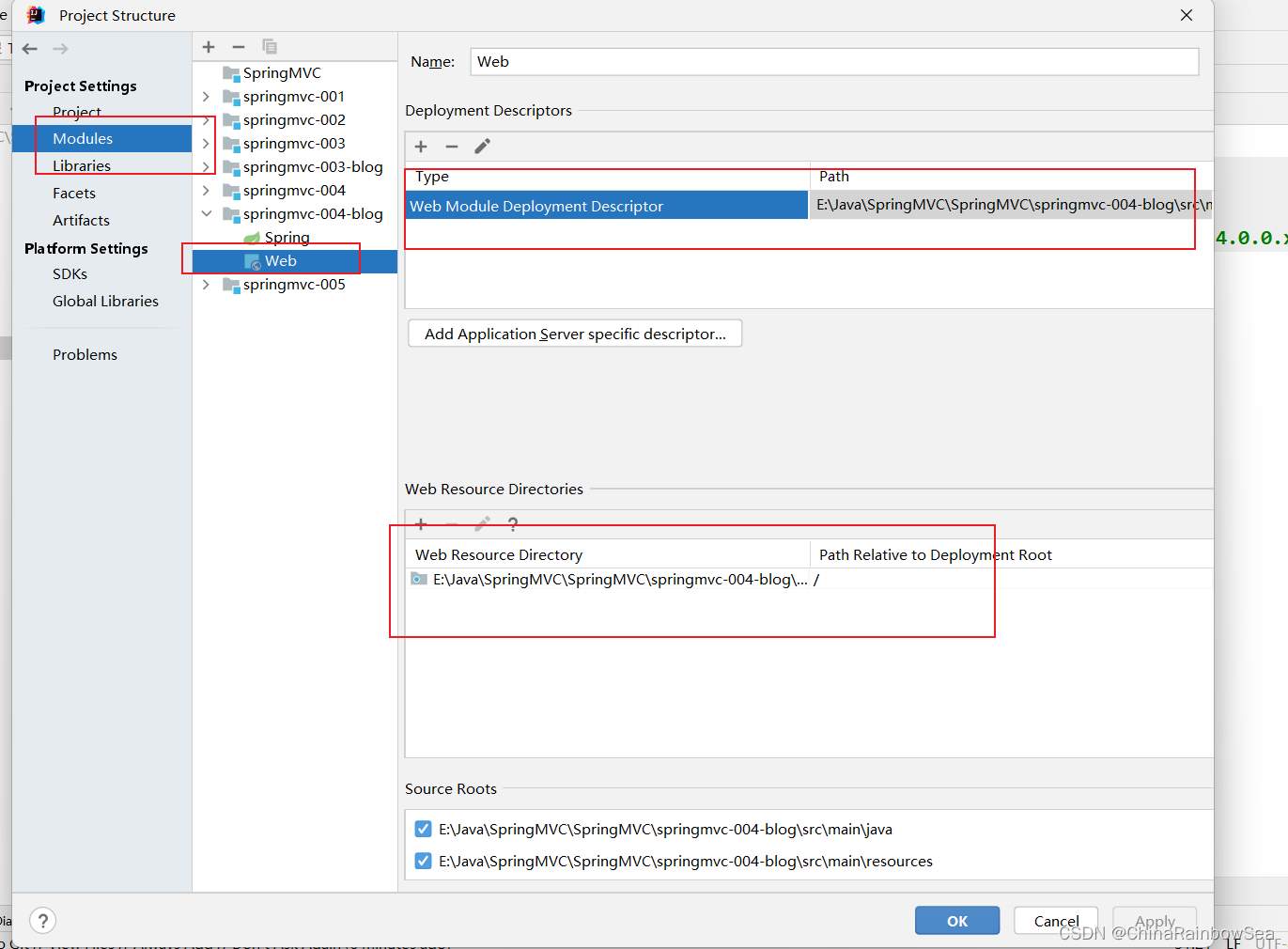
3.3 编写 web.xml 文件
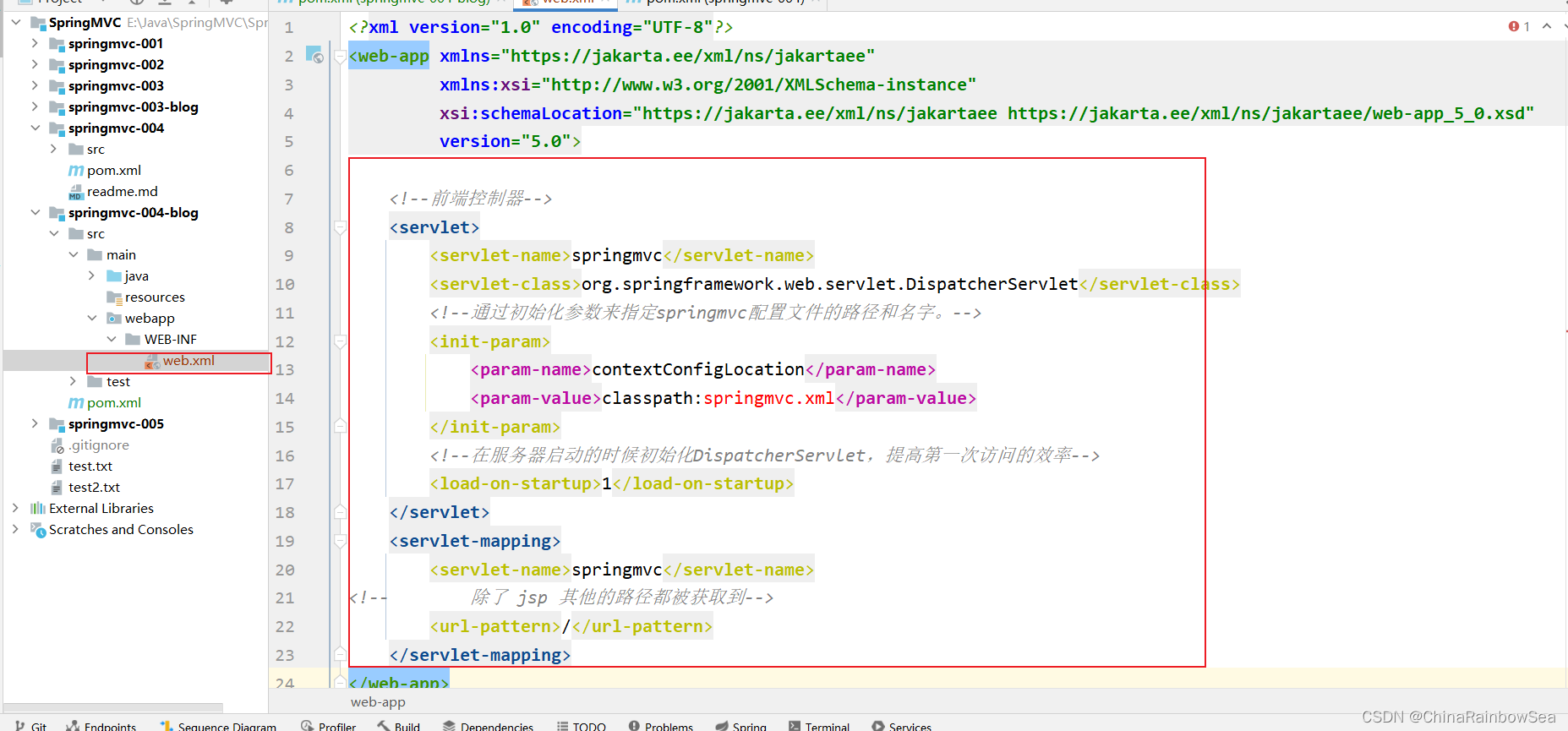
<web-app xmlns="https://jakarta.ee/xml/ns/jakartaee"
xmlns:xsi="http://www.w3.org/2001/XMLSchema-instance"
xsi:schemaLocation="https://jakarta.ee/xml/ns/jakartaee https://jakarta.ee/xml/ns/jakartaee/web-app_5_0.xsd"
version="5.0">
<servlet>
<servlet-name>springmvcservlet-name>
<servlet-class>org.springframework.web.servlet.DispatcherServletservlet-class>
<init-param>
<param-name>contextConfigLocationparam-name>
<param-value>classpath:springmvc.xmlparam-value>
init-param>
<load-on-startup>1load-on-startup>
servlet>
<servlet-mapping>
<servlet-name>springmvcservlet-name>
<url-pattern>/url-pattern>
servlet-mapping>
web-app>
3.4 创建 IndexController 类
创建 IndexController 类作为 首页来使用
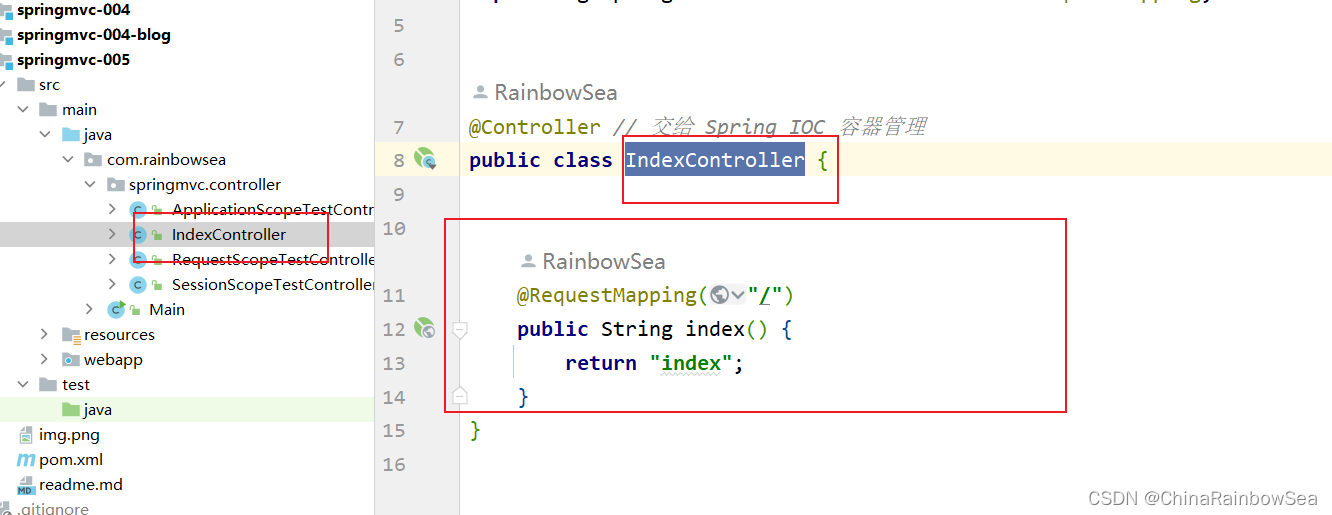
package com.rainbowsea.springmvc.controller;
import org.springframework.stereotype.Controller;
import org.springframework.web.bind.annotation.RequestMapping;
@Controller // 交给 Spring IOC 容器管理
public class IndexController {
@RequestMapping("/")
public String index() {
return "index";
}
}
3.5 编写 springmvc.xml
在 springmvc.xml 当中配置两个信息:
- 组件扫描
- 视图解析器
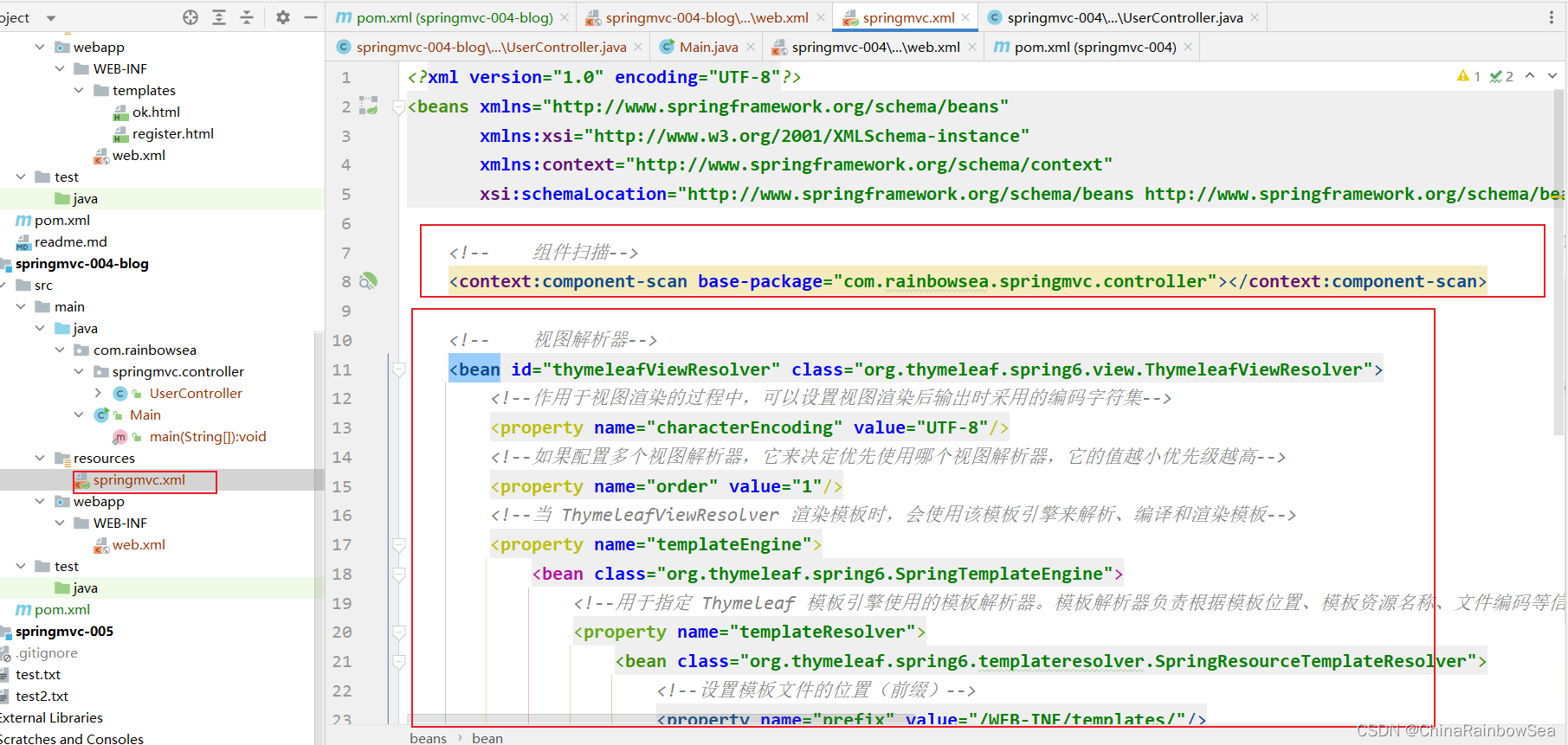
<beans xmlns="http://www.springframework.org/schema/beans"
xmlns:xsi="http://www.w3.org/2001/XMLSchema-instance"
xmlns:context="http://www.springframework.org/schema/context"
xsi:schemaLocation="http://www.springframework.org/schema/beans http://www.springframework.org/schema/beans/spring-beans.xsd http://www.springframework.org/schema/context https://www.springframework.org/schema/context/spring-context.xsd">
<context:component-scan base-package="com.rainbowsea.springmvc.controller">context:component-scan>
<bean id="thymeleafViewResolver" class="org.thymeleaf.spring6.view.ThymeleafViewResolver">
<property name="characterEncoding" value="UTF-8"/>
<property name="order" value="1"/>
<property name="templateEngine">
<bean class="org.thymeleaf.spring6.SpringTemplateEngine">
<property name="templateResolver">
<bean class="org.thymeleaf.spring6.templateresolver.SpringResourceTemplateResolver">
<property name="prefix" value="/WEB-INF/templates/"/>
<property name="suffix" value=".html"/>
<property name="templateMode" value="HTML"/>
<property name="characterEncoding" value="UTF-8"/>
bean>
property>
bean>
property>
bean>
beans>
3.6 编写 index.html 文件视图
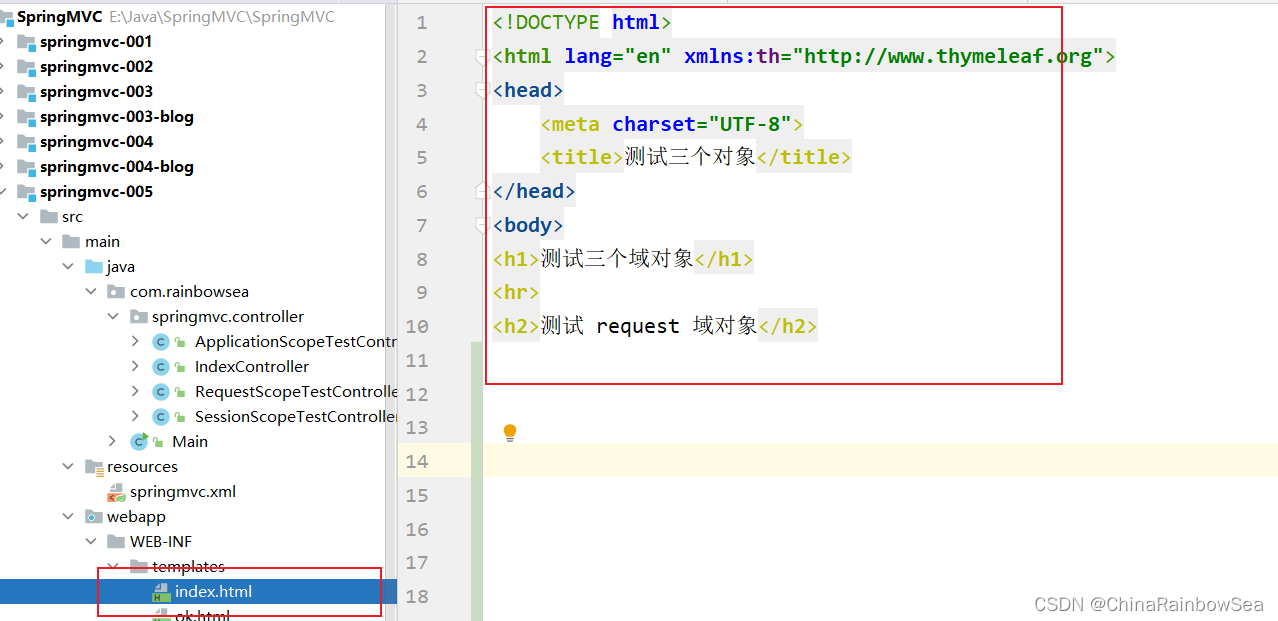
html>
<html lang="en" xmlns:th="http://www.thymeleaf.org">
<head>
<meta charset="UTF-8">
<title>测试三个对象title>
head>
<body>
<h1>测试三个域对象h1>
<hr>
<h2>测试 request 域对象h2>
body>
html>
3.7 部署测试
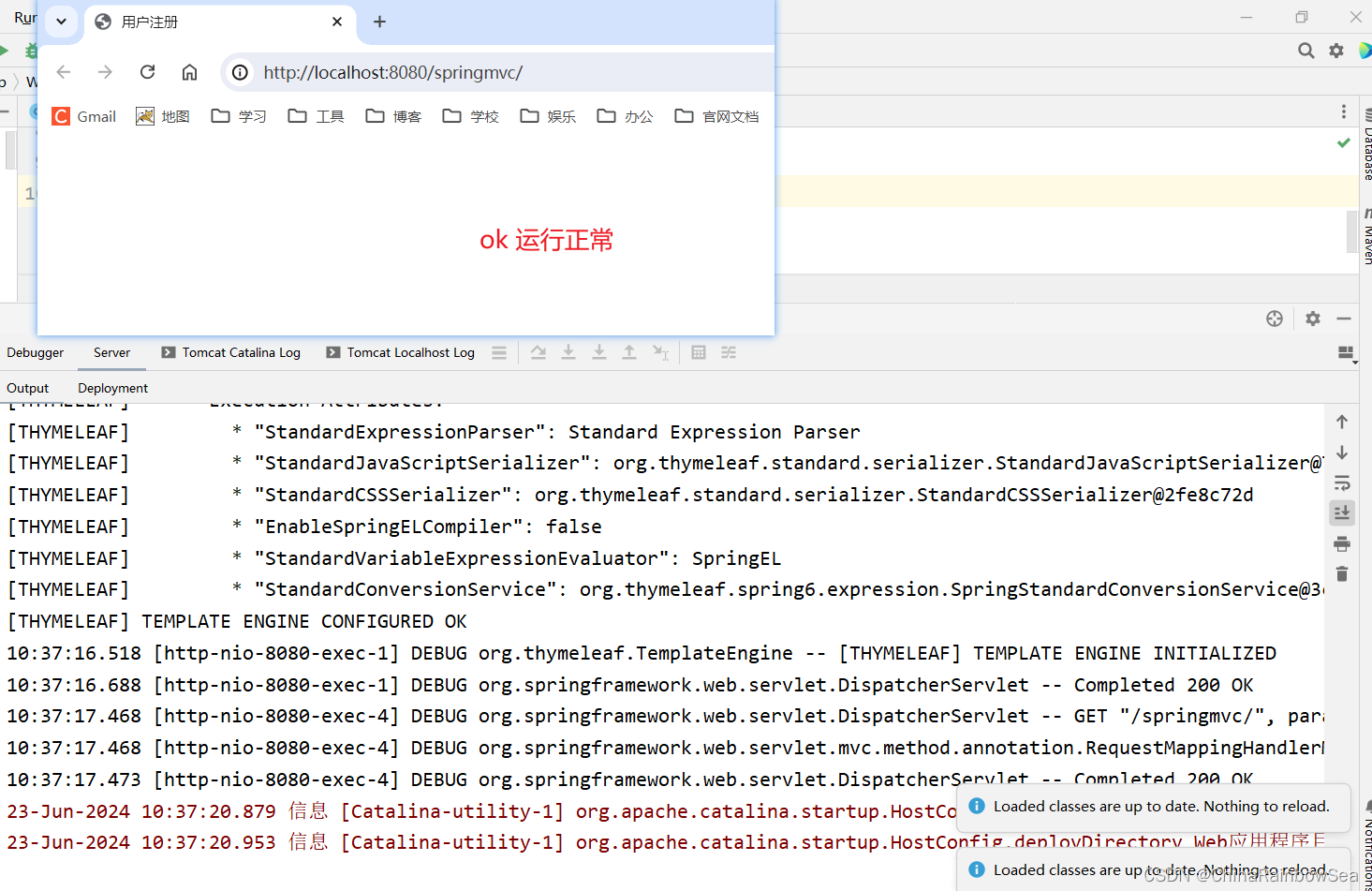
4. Spring MVC 获取 request 请求域对象的五种方式
在SpringMVC中,在request域中共享数据有以下五种方式:
- 使用原生Servlet API方式。
- 使用Model接口。
- 使用Map接口。
- 使用ModelMap类。
- 使用ModelAndView类。
4.1 第一种方式:使用原生Servlet API方式 获取到 request 请求域,同时获取到请求域当中对应的内容
第一种方式: 在Spring MVC 中使用原生的 Servlet API 可以完成 request 域数据共享
,在处理器方法上添加 HttpServletRequest 参数即可。
将 HttpServletRequest 作为参数,定义到方法上,Spring MVC 框架会自动从 Tomcat 服务器当中获取到这个 HttpServletRequest 对象的值,然后,传递给这个方法的 HttpServletRequest 参数值上,完成赋值。
创建一个 RequestScopeTestController 类,注意要交给 Spring IOC 容器管理起来
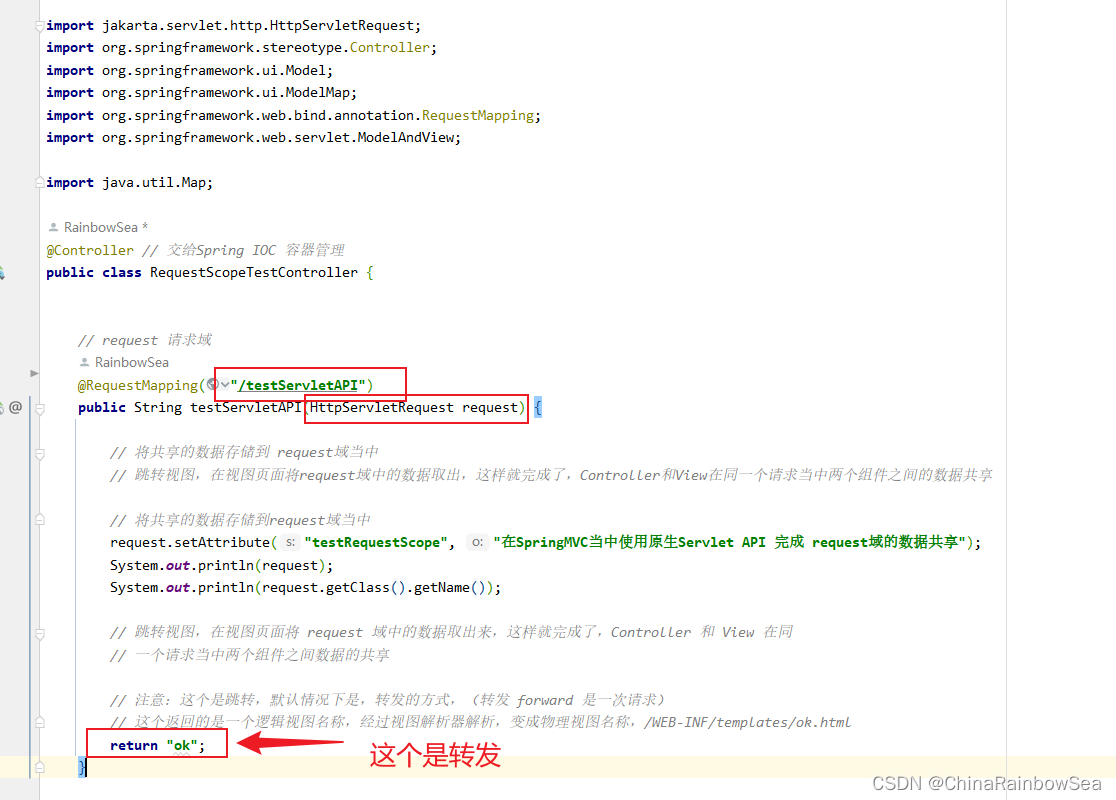
package com.rainbowsea.springmvc.controller;
import jakarta.servlet.http.HttpServletRequest;
import org.springframework.stereotype.Controller;
import org.springframework.ui.Model;
import org.springframework.ui.ModelMap;
import org.springframework.web.bind.annotation.RequestMapping;
import org.springframework.web.servlet.ModelAndView;
import java.util.Map;
@Controller // 交给Spring IOC 容器管理
public class RequestScopeTestController {
// request 请求域
@RequestMapping("/testServletAPI")
public String testServletAPI(HttpServletRequest request) {
// 将共享的数据存储到 request域当中
// 跳转视图,在视图页面将request域中的数据取出,这样就完成了,Controller和View在同一个请求当中两个组件之间的数据共享
// 将共享的数据存储到request域当中
request.setAttribute("testRequestScope", "在SpringMVC当中使用原生Servlet API 完成 request域的数据共享");
System.out.println(request);
System.out.println(request.getClass().getName());
// 跳转视图,在视图页面将 request 域中的数据取出来,这样就完成了,Controller 和 View 在同
// 一个请求当中两个组件之间数据的共享
// 注意:这个是跳转,默认情况下是,转发的方式,(转发 forward 是一次请求)
// 这个返回的是一个逻辑视图名称,经过视图解析器解析,变成物理视图名称,/WEB-INF/templates/ok.html
return "ok";
}
}
index页面超链接的编写:
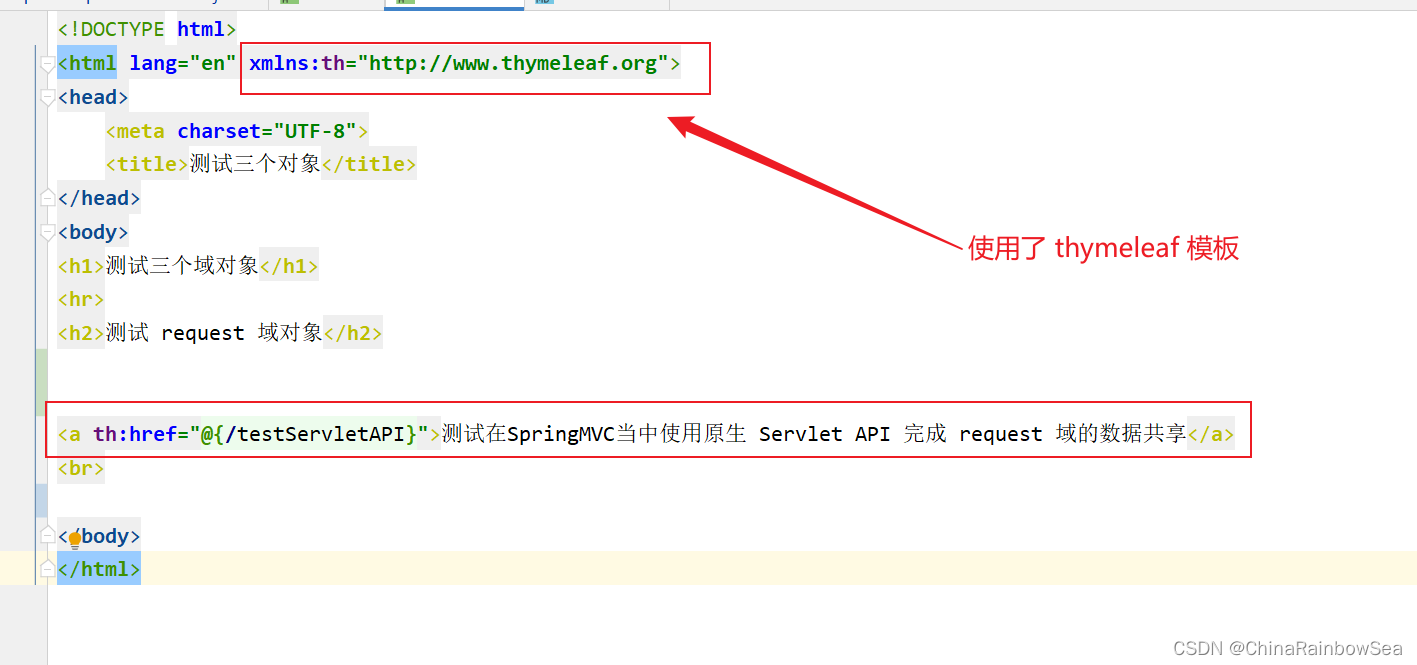
html>
<html lang="en" xmlns:th="http://www.thymeleaf.org">
<head>
<meta charset="UTF-8">
<title>测试三个对象title>
head>
<body>
<h1>测试三个域对象h1>
<hr>
<h2>测试 request 域对象h2>
<a th:href="@{/testServletAPI}">测试在SpringMVC当中使用原生 Servlet API 完成 request 域的数据共享a>
<br>
body>
html>
ok 页面获取 request 请求域的展示
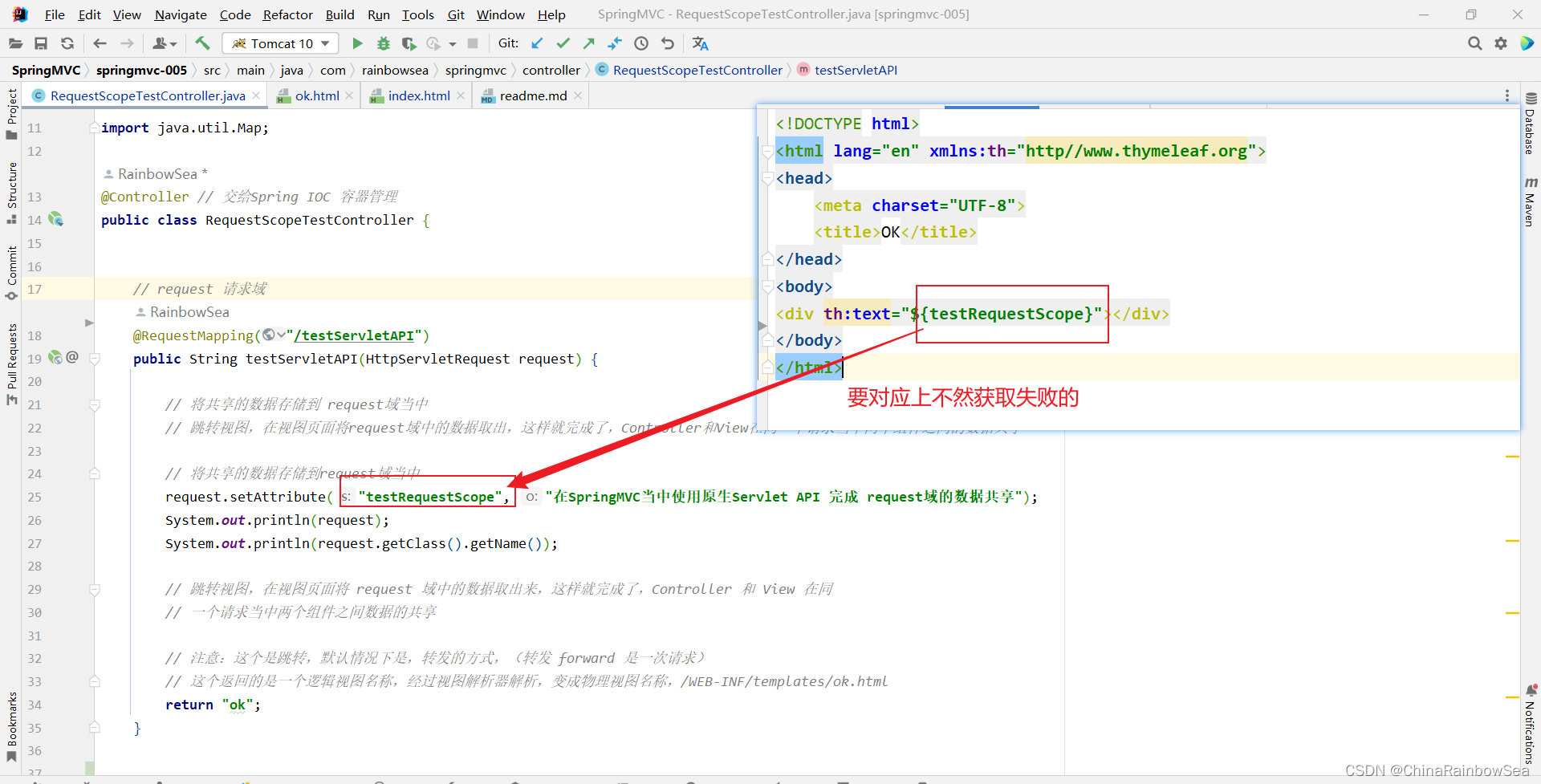
html>
<html lang="en" xmlns:th="http://www.thymeleaf.org">
<head>
<meta charset="UTF-8">
<title>测试三个对象title>
head>
<body>
<h1>测试三个域对象h1>
<hr>
<h2>测试 request 域对象h2>
<a th:href="@{/testServletAPI}">测试在SpringMVC当中使用原生 Servlet API 完成 request 域的数据共享a>
<br>
body>
html>
测试结果:
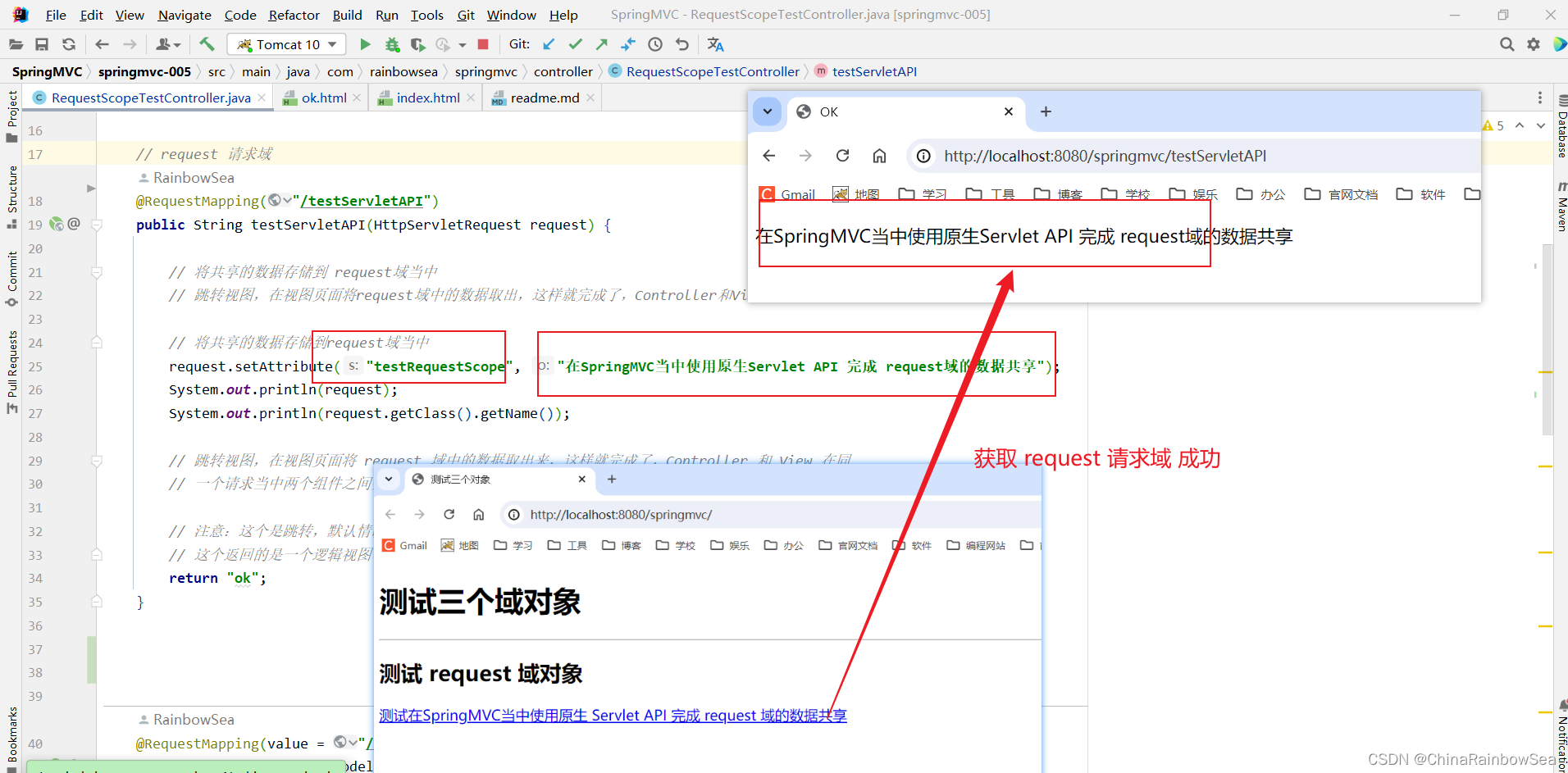
这种方式当然可以,用 SpringMVC 框架,不建议使用原生 Servlet API
4.2 第二种方式:使用 Model 接口 获取到 request 请求域,同时获取到请求域当中对应的内容

import jakarta.servlet.http.HttpServletRequest;
import org.springframework.stereotype.Controller;
import org.springframework.ui.Model;
import org.springframework.ui.ModelMap;
import org.springframework.web.bind.annotation.RequestMapping;
import org.springframework.web.servlet.ModelAndView;
import java.util.Map;
@Controller // 交给Spring IOC 容器管理
public class RequestScopeTestController {
@RequestMapping(value = "/testModel")
public String testModel(Model model) {
// 向 request 域当中绑定数据
model.addAttribute("testRequestScope", "在SpringMVC 当中使用 Model 接口完成 request 域数据共享");
System.out.println(model);
System.out.println(model.getClass().getName());
// 转发
return "ok";
}
}
index 页面超链接的编写:
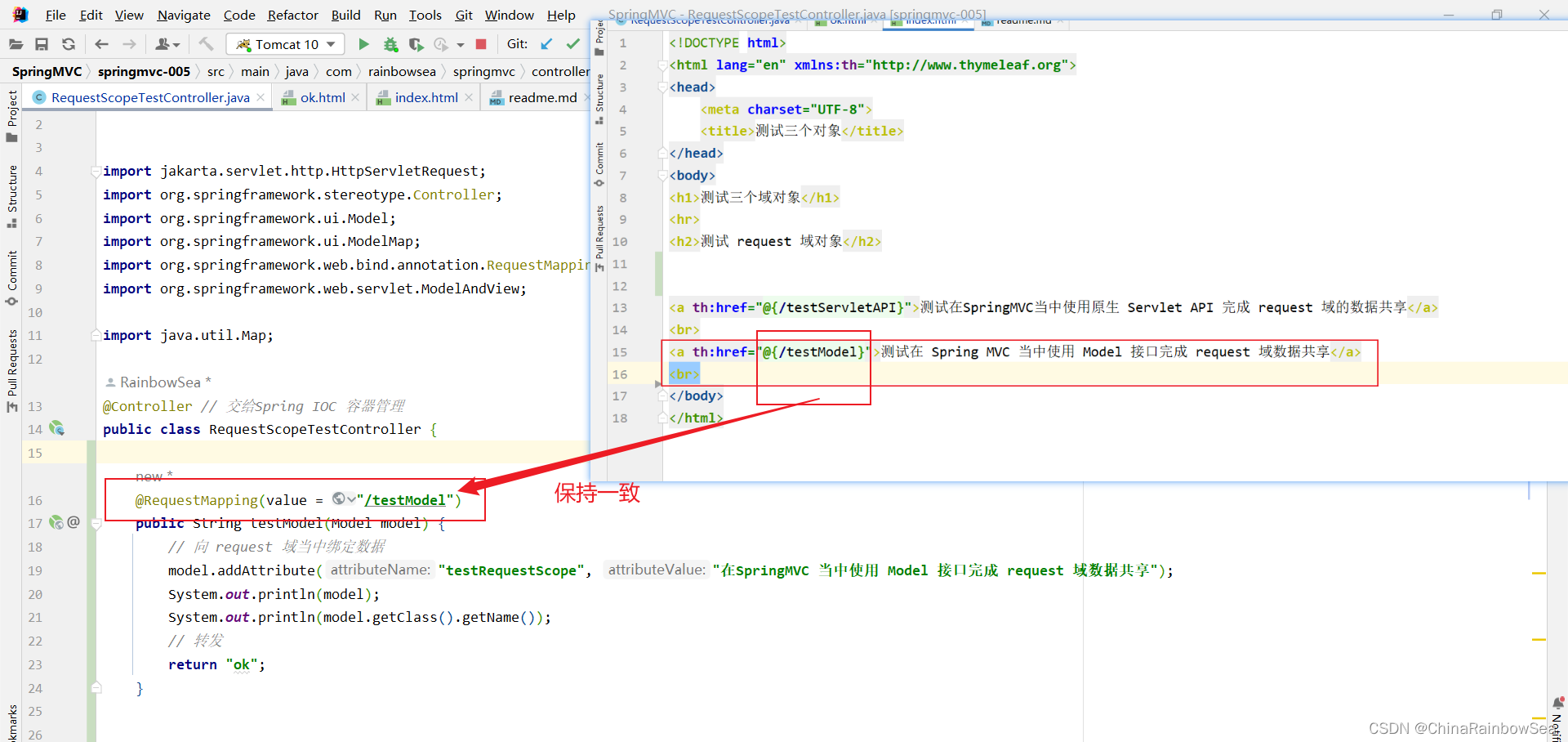
html>
<html lang="en" xmlns:th="http://www.thymeleaf.org">
<head>
<meta charset="UTF-8">
<title>测试三个对象title>
head>
<body>
<h1>测试三个域对象h1>
<hr>
<h2>测试 request 域对象h2>
<a th:href="@{/testServletAPI}">测试在SpringMVC当中使用原生 Servlet API 完成 request 域的数据共享a>
<br>
<a th:href="@{/testModel}">测试在 Spring MVC 当中使用 Model 接口完成 request 域数据共享a>
<br>
body>
html>
ok 页面获取 request 请求域的展示
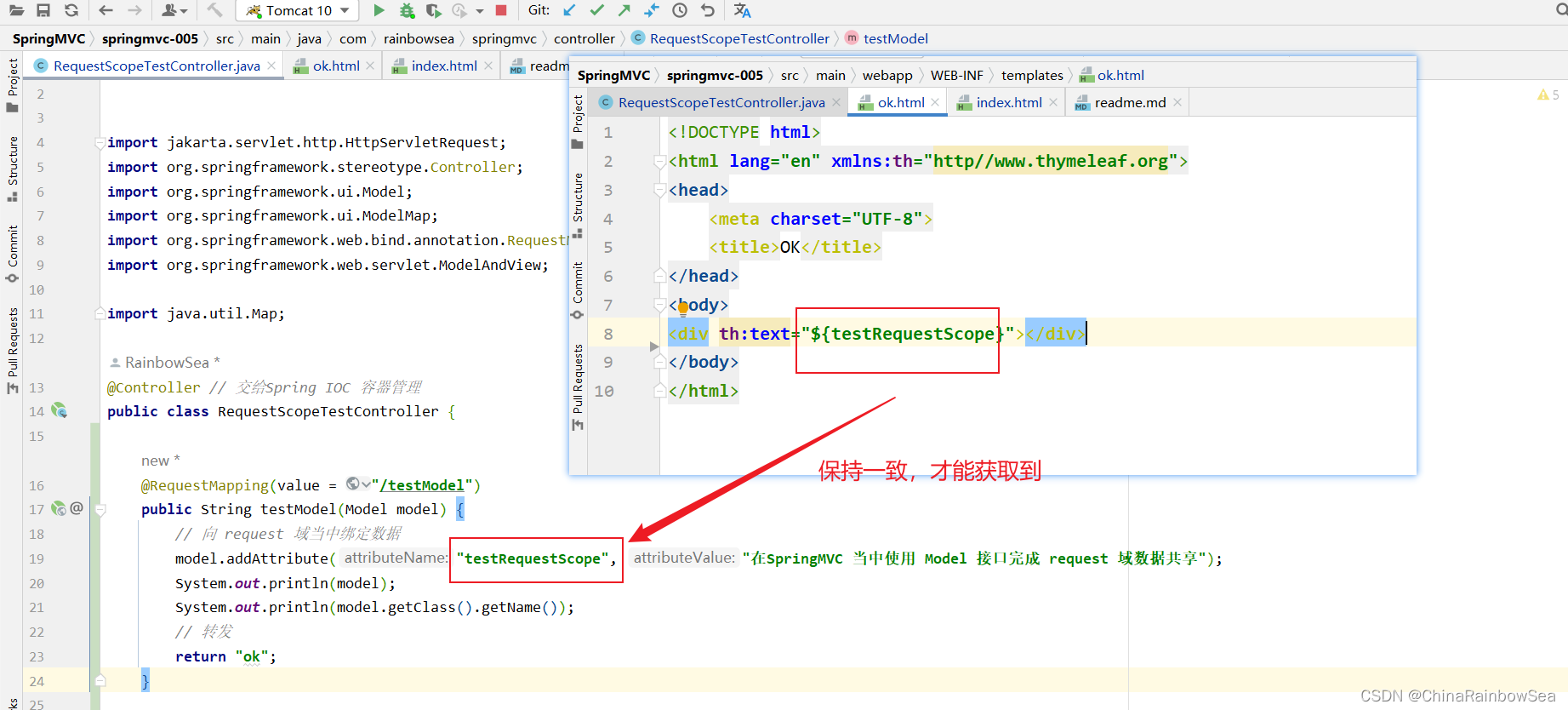
html>
<html lang="en" xmlns:th="http//www.thymeleaf.org">
<head>
<meta charset="UTF-8">
<title>OKtitle>
head>
<body>
<div th:text="${testRequestScope}">div>
body>
html>
启动 Tomcat 服务器测试结果:
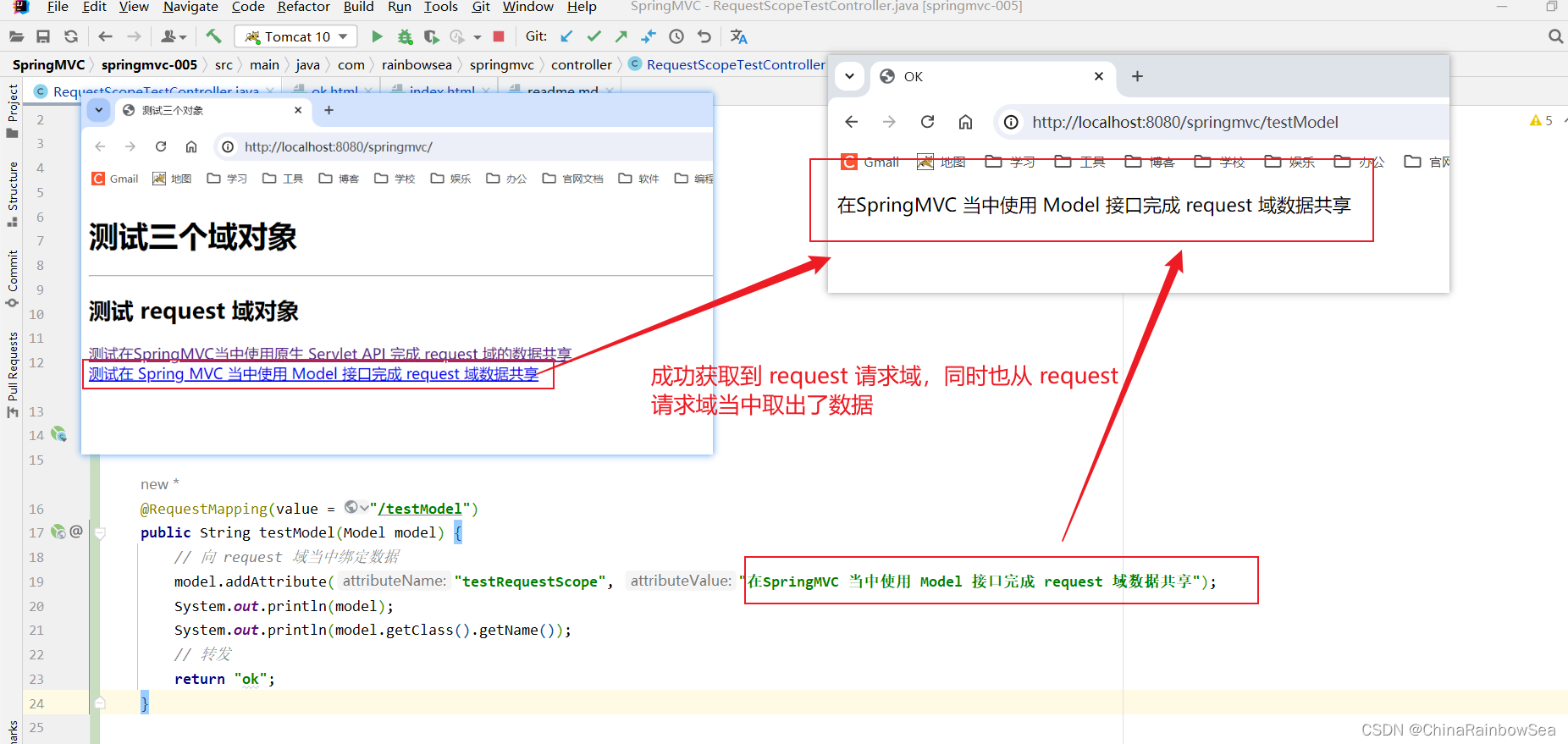
4.3 第三种方式:使用Map接口 获取到 request 请求域,同时获取到请求域当中对应的内容
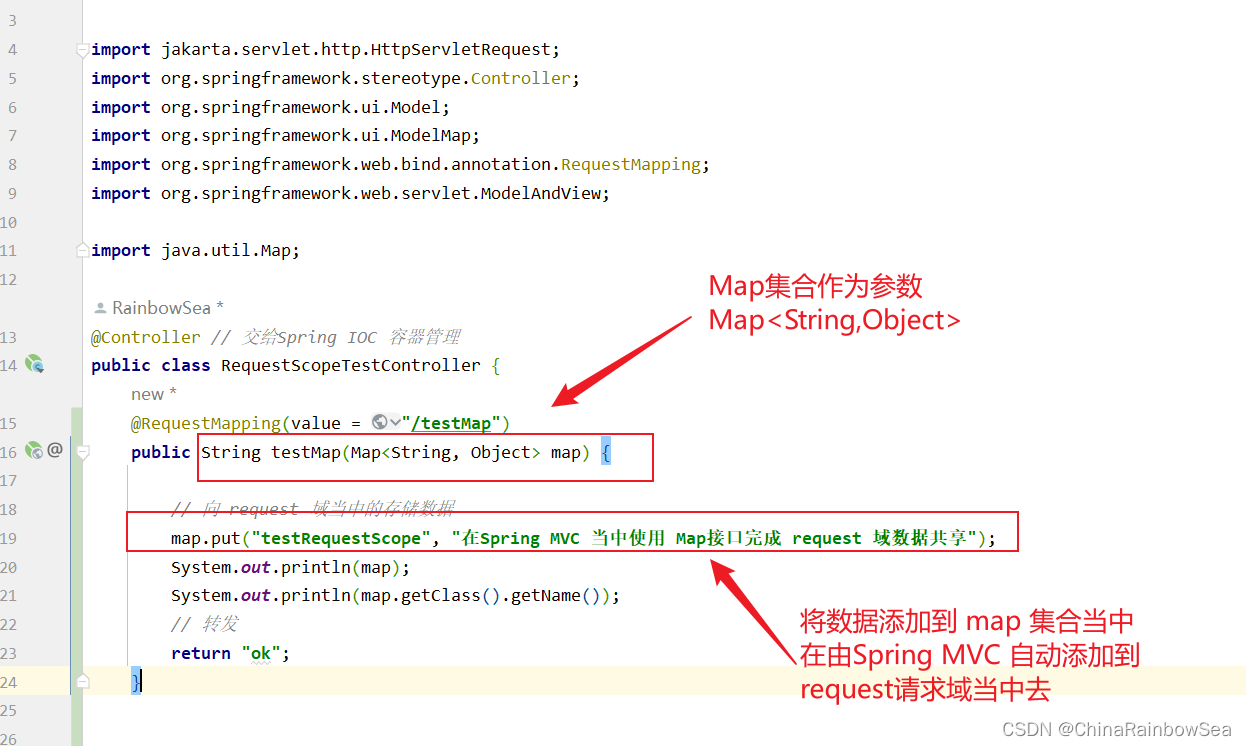
import jakarta.servlet.http.HttpServletRequest;
import org.springframework.stereotype.Controller;
import org.springframework.ui.Model;
import org.springframework.ui.ModelMap;
import org.springframework.web.bind.annotation.RequestMapping;
import org.springframework.web.servlet.ModelAndView;
import java.util.Map;
@Controller // 交给Spring IOC 容器管理
public class RequestScopeTestController {
@RequestMapping(value = "/testMap")
public String testMap(Map map) {
// 向 request 域当中的存储数据
map.put("testRequestScope", "在Spring MVC 当中使用 Map接口完成 request 域数据共享");
System.out.println(map);
System.out.println(map.getClass().getName());
// 转发
return "ok";
}
}
index 页面超链接的编写:
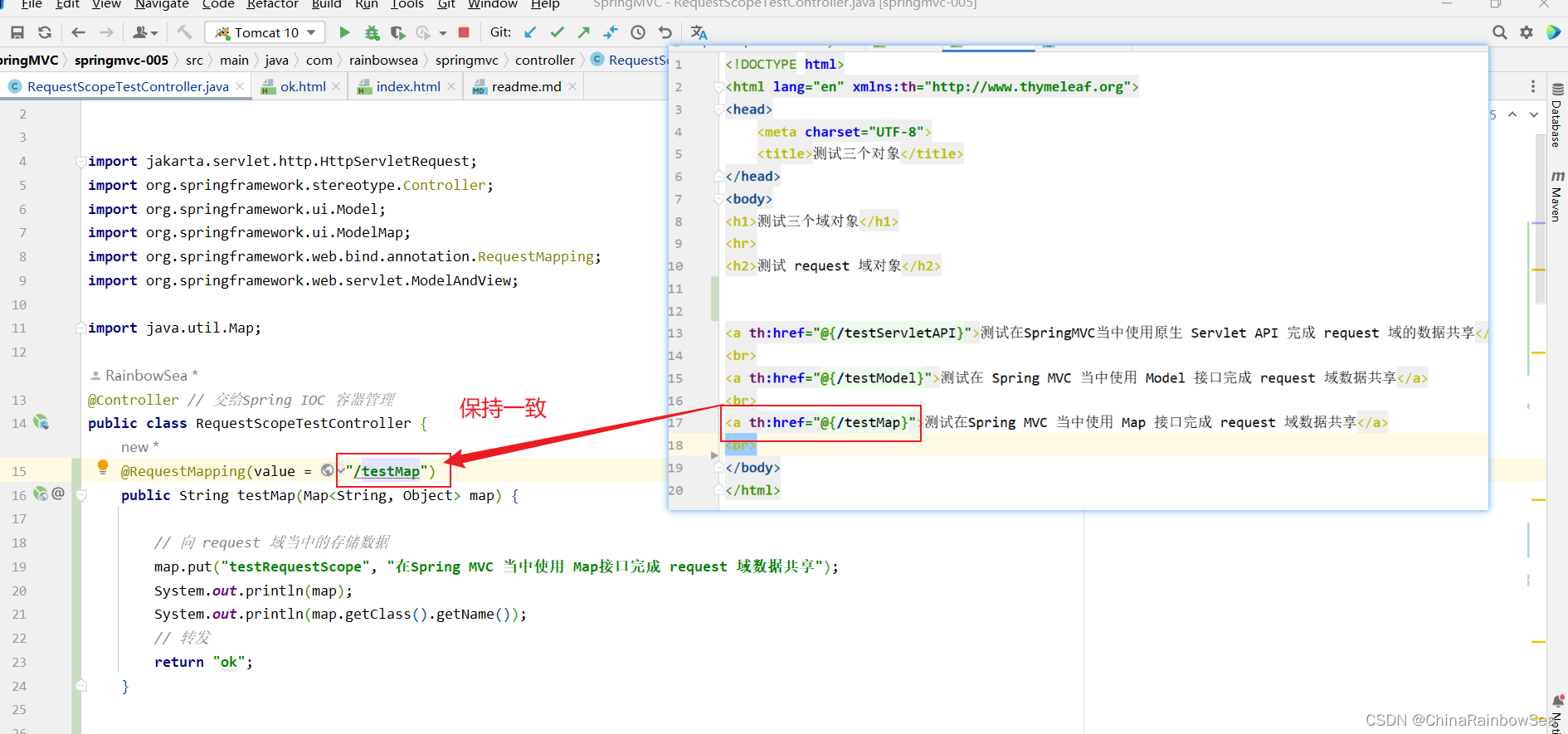
html>
<html lang="en" xmlns:th="http://www.thymeleaf.org">
<head>
<meta charset="UTF-8">
<title>测试三个对象title>
head>
<body>
<h1>测试三个域对象h1>
<hr>
<h2>测试 request 域对象h2>
<a th:href="@{/testServletAPI}">测试在SpringMVC当中使用原生 Servlet API 完成 request 域的数据共享a>
<br>
<a th:href="@{/testModel}">测试在 Spring MVC 当中使用 Model 接口完成 request 域数据共享a>
<br>
<a th:href="@{/testMap}">测试在Spring MVC 当中使用 Map 接口完成 request 域数据共享a>
<br>
body>
html>
ok 页面获取 request 请求域的展示 保持不变
启动 Tomcat 服务器测试结果:
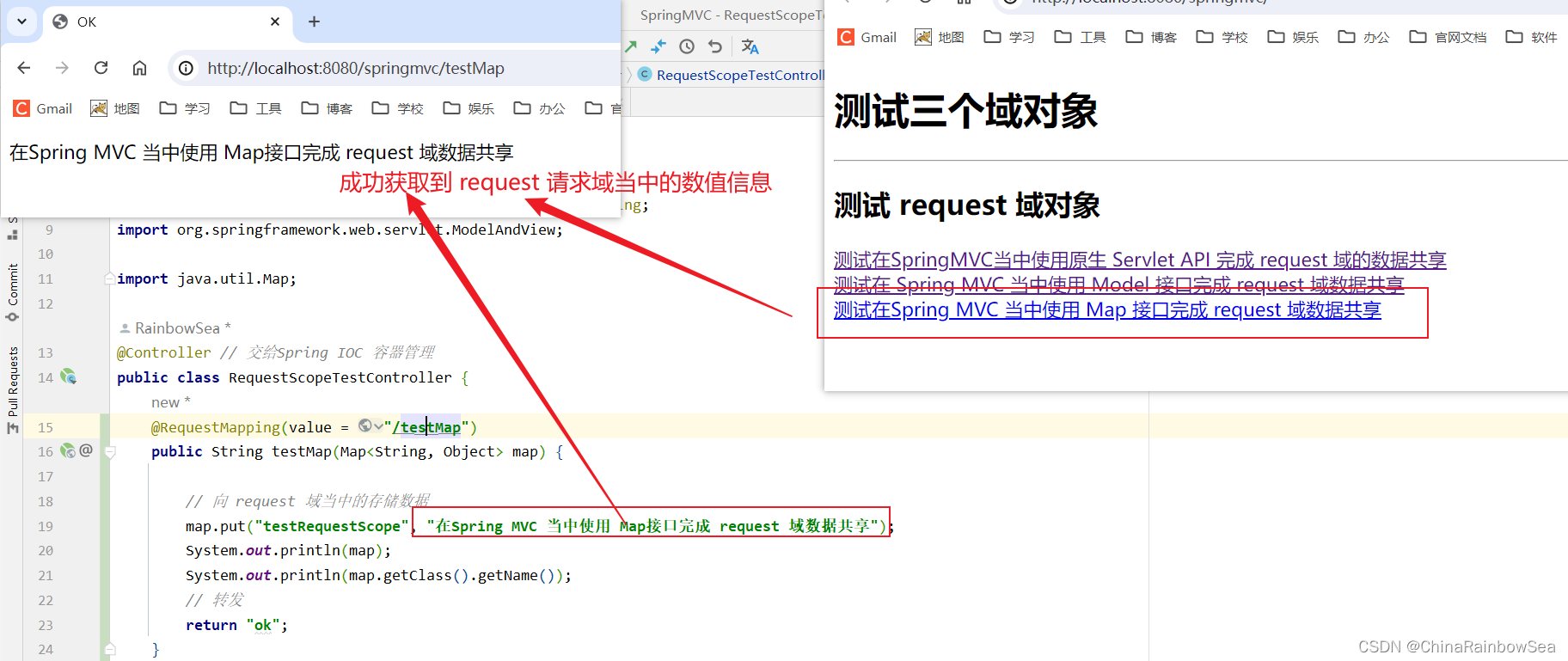
4.4 第四种方式:使用 ModelMap 类 获取到 request 请求域,同时获取到请求域当中对应的内容

import jakarta.servlet.http.HttpServletRequest;
import org.springframework.stereotype.Controller;
import org.springframework.ui.Model;
import org.springframework.ui.ModelMap;
import org.springframework.web.bind.annotation.RequestMapping;
import org.springframework.web.servlet.ModelAndView;
import java.util.Map;
@Controller // 交给Spring IOC 容器管理
public class RequestScopeTestController {
@RequestMapping(value = "/testModelMap")
public String testModelMap(ModelMap modelMap) {
// 向 request 域当中存储数据
modelMap.addAttribute("testRequestScope", "在Spring MVC 当中 ModelMap类完成request 域数据共享");
System.out.println(modelMap);
System.out.println(modelMap.getClass().getName());
return "ok";
}
}
index 页面超链接的编写:
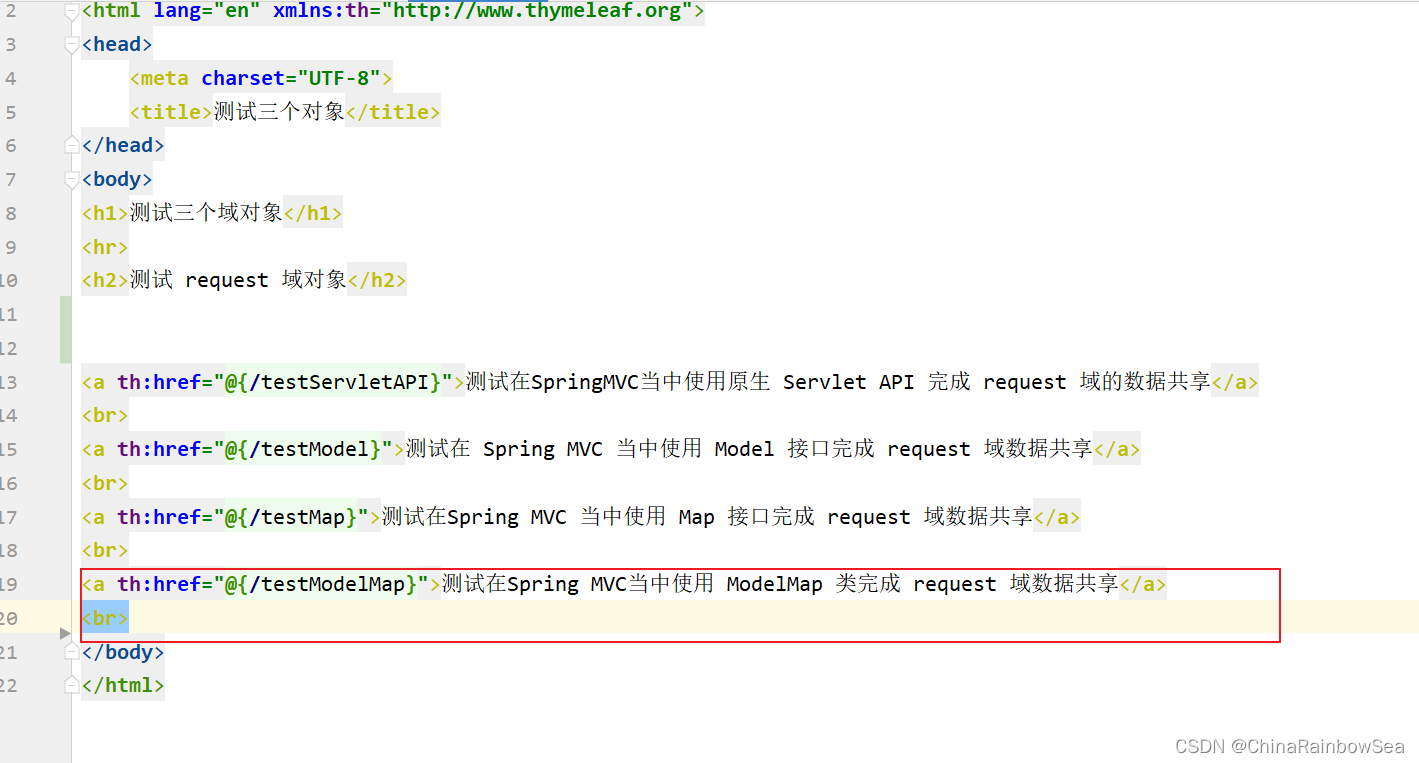
html>
<html lang="en" xmlns:th="http://www.thymeleaf.org">
<head>
<meta charset="UTF-8">
<title>测试三个对象title>
head>
<body>
<h1>测试三个域对象h1>
<hr>
<h2>测试 request 域对象h2>
<a th:href="@{/testServletAPI}">测试在SpringMVC当中使用原生 Servlet API 完成 request 域的数据共享a>
<br>
<a th:href="@{/testModel}">测试在 Spring MVC 当中使用 Model 接口完成 request 域数据共享a>
<br>
<a th:href="@{/testMap}">测试在Spring MVC 当中使用 Map 接口完成 request 域数据共享a>
<br>
<a th:href="@{/testModelMap}">测试在Spring MVC当中使用 ModelMap 类完成 request 域数据共享a>
<br>
body>
html>
ok 页面获取 request 请求域的展示 保持不变
启动 Tomcat 服务器测试结果:
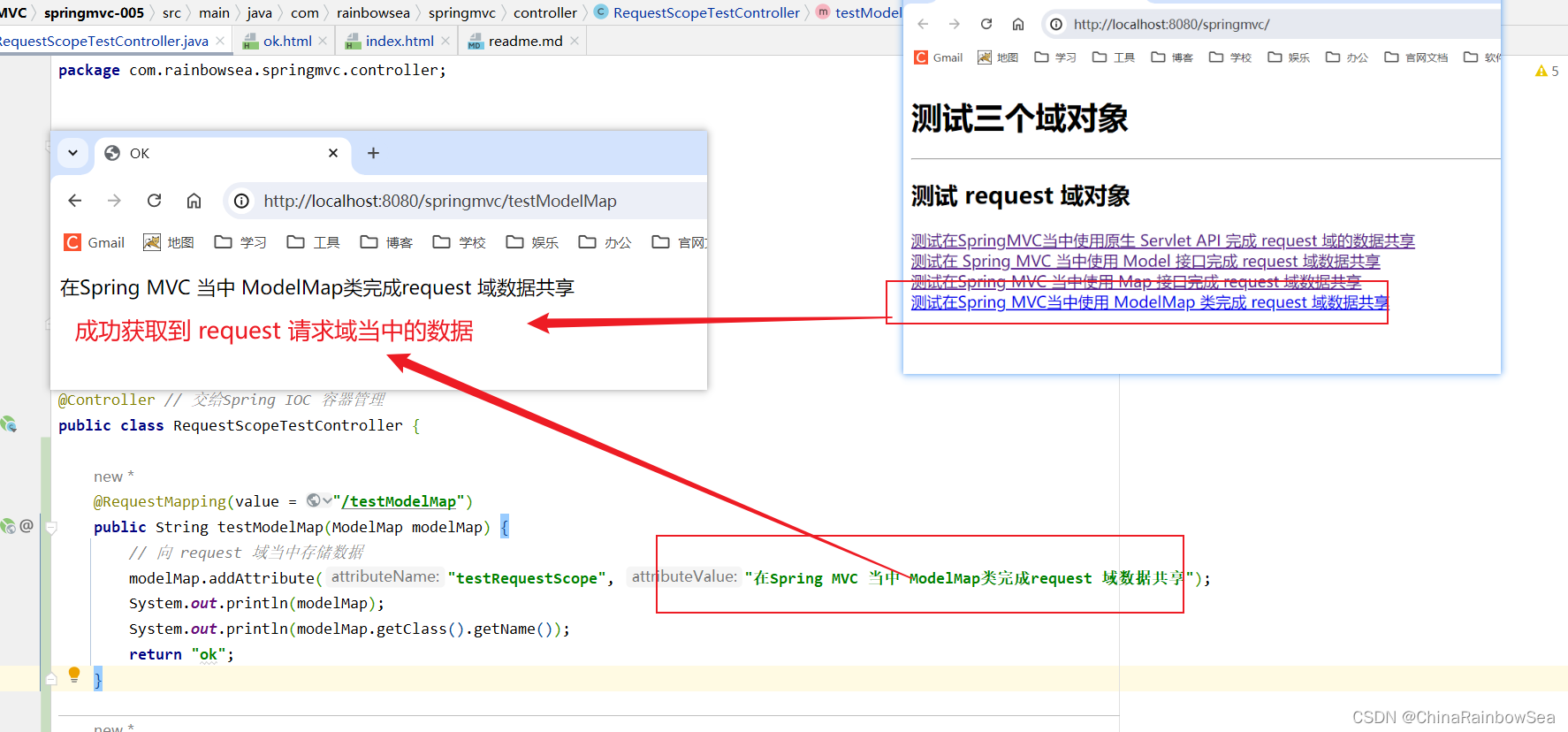
4.5 补充:Model、Map、ModelMap的关系
可以在以上Model、Map、ModelMap的测试程序中将其输出,看看输出什么:
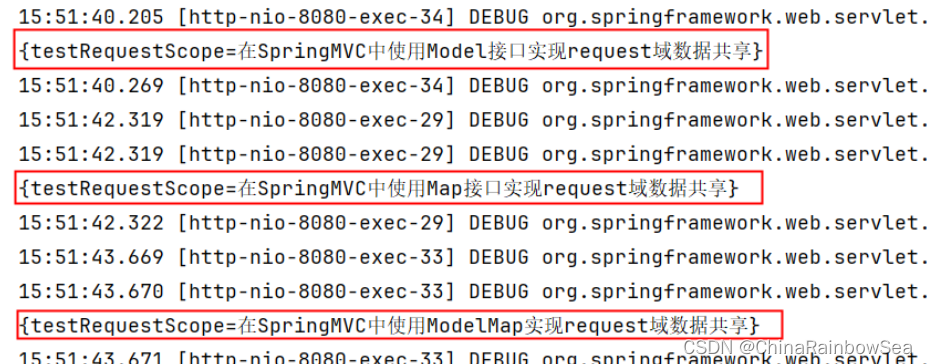
看不出来什么区别,从输出结果上可以看到都是一样的。
可以将其运行时类名输出:
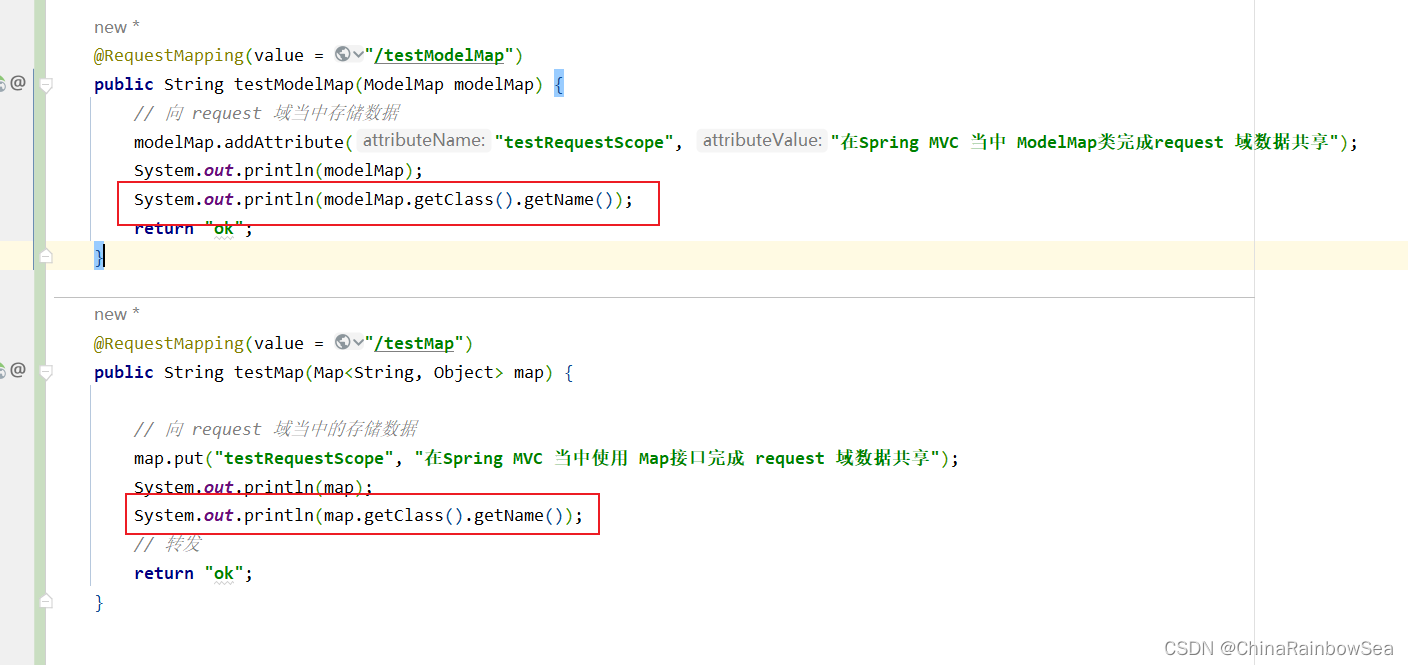
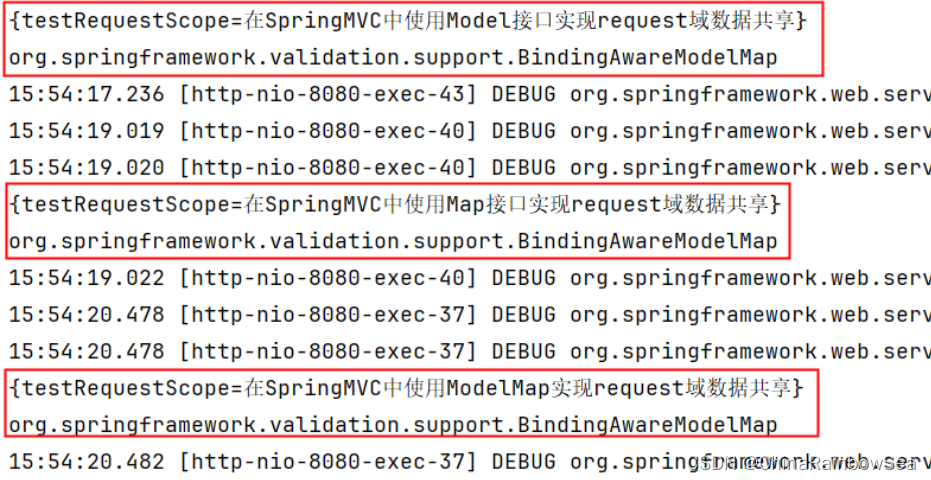
通过输出结果可以看出,无论是Model、Map还是ModelMap,底层实例化的对象都是:BindingAwareModelMap。
可以查看 BindingAwareModelMap的继承结构:
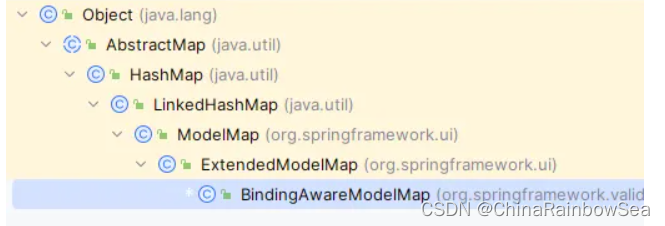
通过继承结构可以看出:BindingAwareModelMap继承了ModelMap,而ModelMap又实现了Map接口。
另外,请看以下源码:

可以看出ModelMap又实现了Model接口。因此表面上是采用了不同方式,底层本质上是相同的。
SpringMVC之所以提供了这些方式,目的就是方便程序员的使用,提供了多样化的方式,可见它的重要性。
4.6 第五种方式:使用 ModelAndView 类获取到 request 请求域,同时获取到请求域当中对应的内容
在 Spring MVC 框架中为了更好的体现 MVC 架构模式,提供了一个类:ModelAndView。
这个类的实例封装了 Model 和 View 。也就是说 这个类封装业务处理之后的数据,也体现了跳转到哪个视图。使用它也可以完成 request 域数据共享。
使用这种方式的注意事项:
- 方法的返回值类型不是 String 了,而是 ModelAndView 对象
- ModelAndView 不是出现在方法的参数位置上了,而是在方法体中 new 出来的
- 需要调用
addObject()向域中存储数据- 需要调用
setViewName()设置视图的名字- 最后需要将 ModelAndView 作为参数,返回。
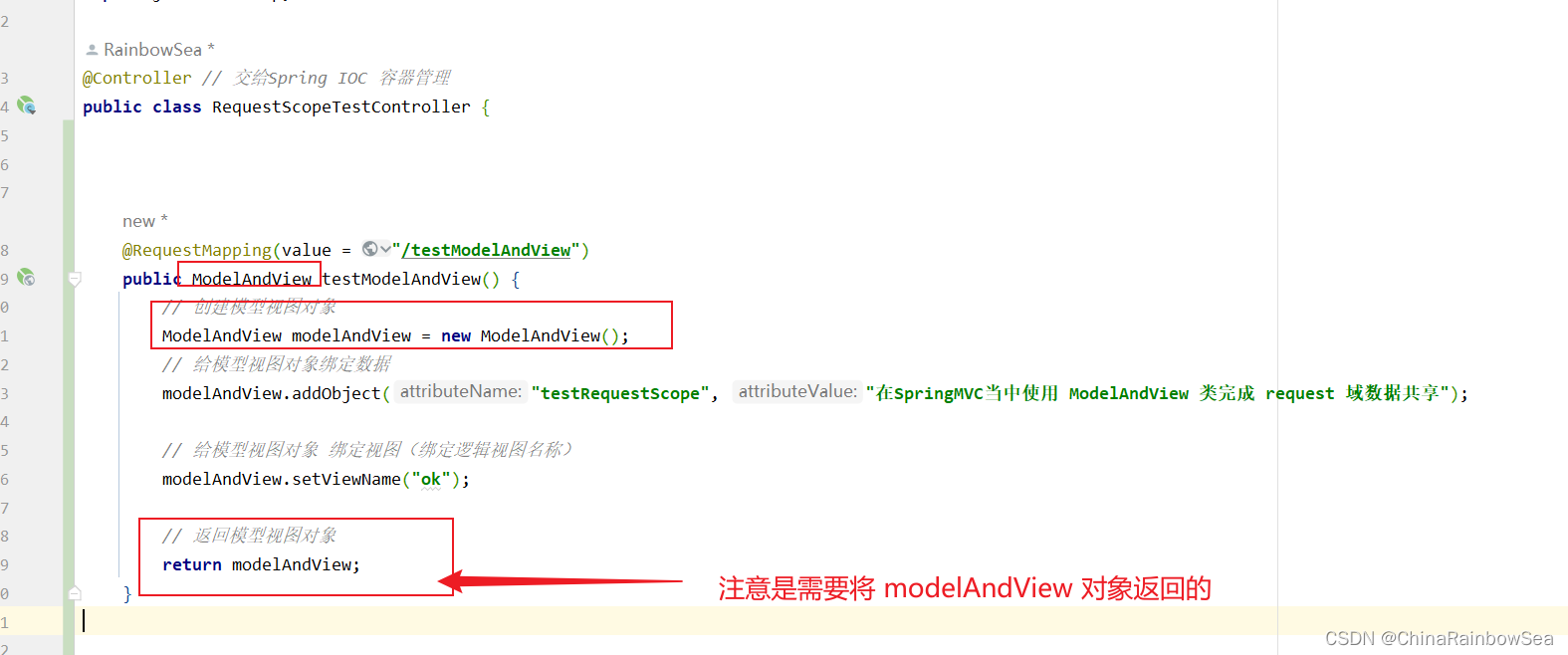
import jakarta.servlet.http.HttpServletRequest;
import org.springframework.stereotype.Controller;
import org.springframework.ui.Model;
import org.springframework.ui.ModelMap;
import org.springframework.web.bind.annotation.RequestMapping;
import org.springframework.web.servlet.ModelAndView;
import java.util.Map;
@Controller // 交给Spring IOC 容器管理
public class RequestScopeTestController {
@RequestMapping(value = "/testModelAndView")
public ModelAndView testModelAndView() {
// 创建模型视图对象
ModelAndView modelAndView = new ModelAndView();
// 给模型视图对象绑定数据
modelAndView.addObject("testRequestScope", "在SpringMVC当中使用 ModelAndView 类完成 request 域数据共享");
// 给模型视图对象 绑定视图(绑定逻辑视图名称)
modelAndView.setViewName("ok");
// 返回模型视图对象
return modelAndView;
}
}
index页面超链接的编写:
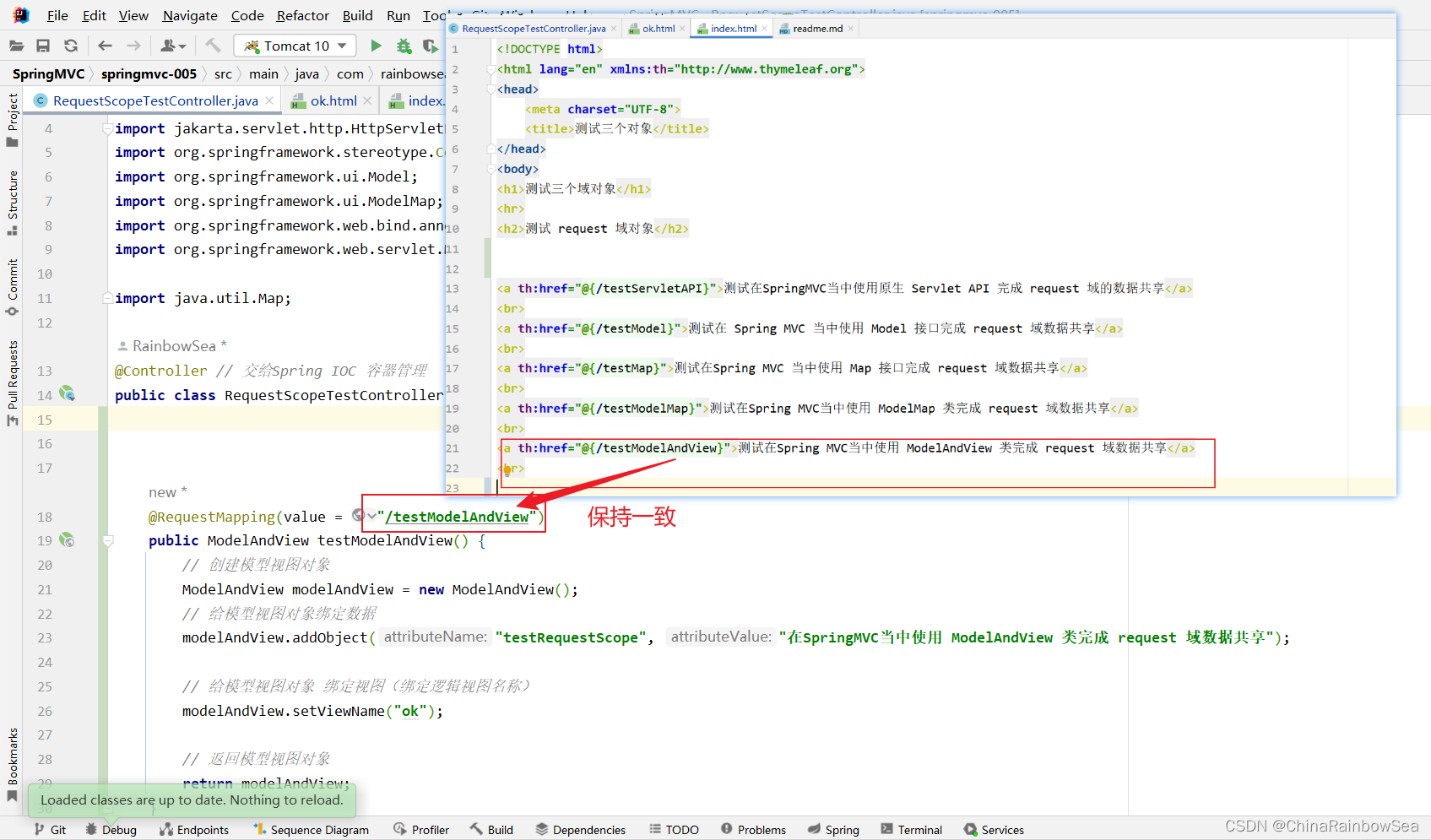
html>
<html lang="en" xmlns:th="http://www.thymeleaf.org">
<head>
<meta charset="UTF-8">
<title>测试三个对象title>
head>
<body>
<h1>测试三个域对象h1>
<hr>
<h2>测试 request 域对象h2>
<a th:href="@{/testServletAPI}">测试在SpringMVC当中使用原生 Servlet API 完成 request 域的数据共享a>
<br>
<a th:href="@{/testModel}">测试在 Spring MVC 当中使用 Model 接口完成 request 域数据共享a>
<br>
<a th:href="@{/testMap}">测试在Spring MVC 当中使用 Map 接口完成 request 域数据共享a>
<br>
<a th:href="@{/testModelMap}">测试在Spring MVC当中使用 ModelMap 类完成 request 域数据共享a>
<br>
<a th:href="@{/testModelAndView}">测试在Spring MVC当中使用 ModelAndView 类完成 request 域数据共享a>
<br>
body>
html>
ok 页面获取 request 请求域的展示的编写:
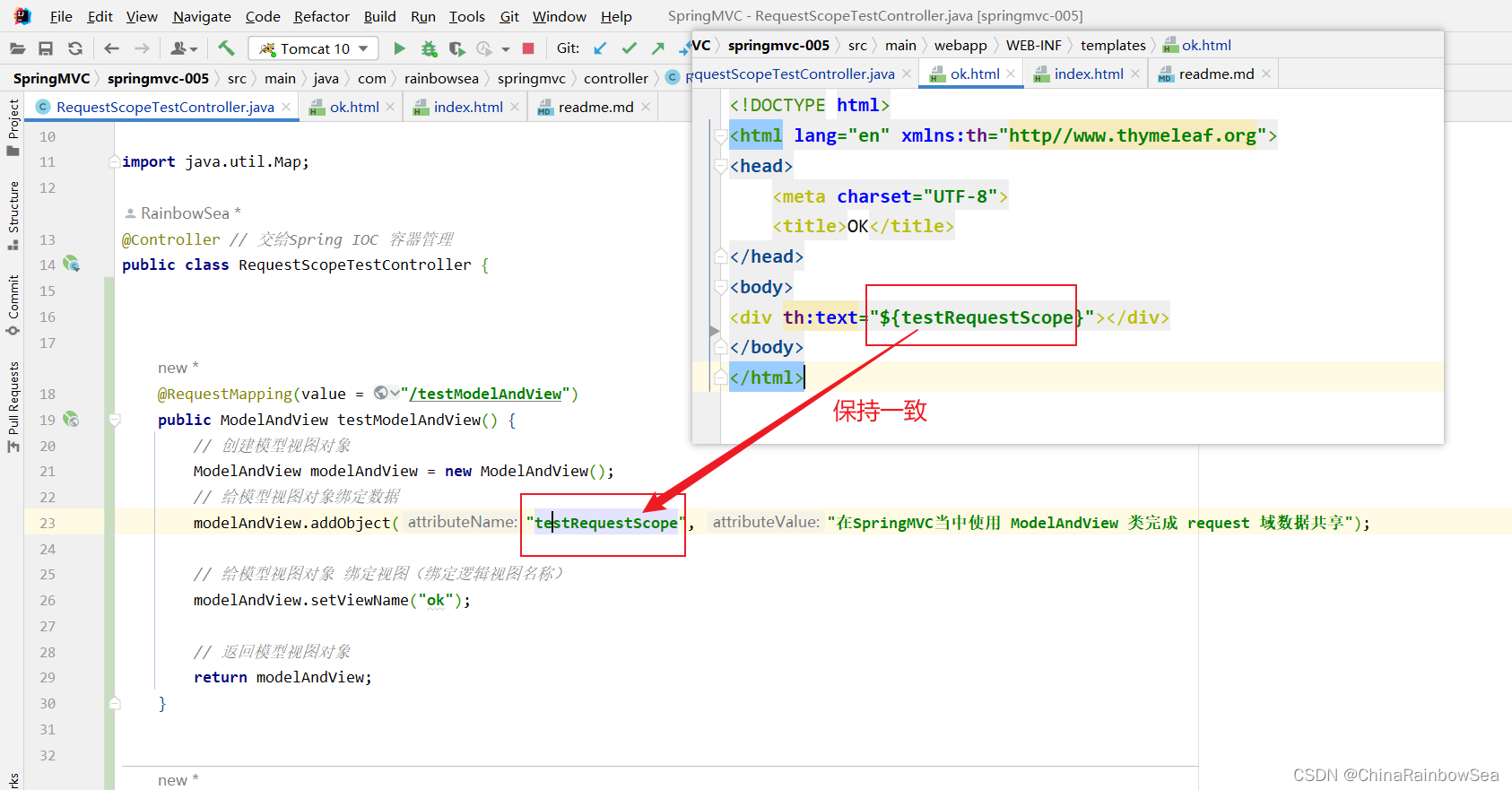
html>
<html lang="en" xmlns:th="http//www.thymeleaf.org">
<head>
<meta charset="UTF-8">
<title>OKtitle>
head>
<body>
<div th:text="${testRequestScope}">div>
body>
html>
启动 Tomcat 服务器测试结果:
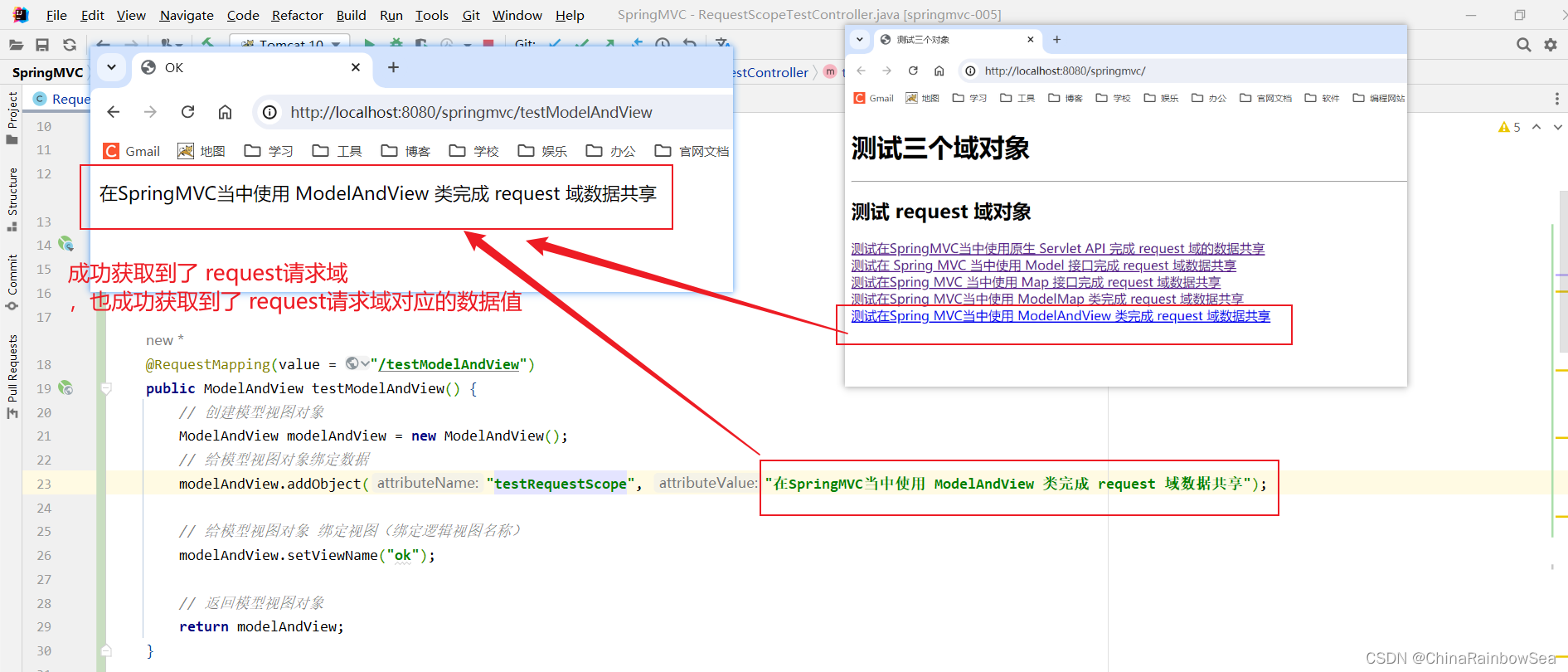
4.7 补充:ModelAndView 源码分析
以上我们通过了五种方式完成了request域数据共享,包括:原生 Servlet API,Model、Map、ModelMap、ModelAndView
其中后四种:Model、Map、ModelMap、ModelAndView。
这四种方式在底层DispatcherServlet调用我们的Controller之后,返回的对象都是ModelAndView,
这个可以通过源码进行分析。
在以上四种方式中,拿Model举例,添加断点进行调试:
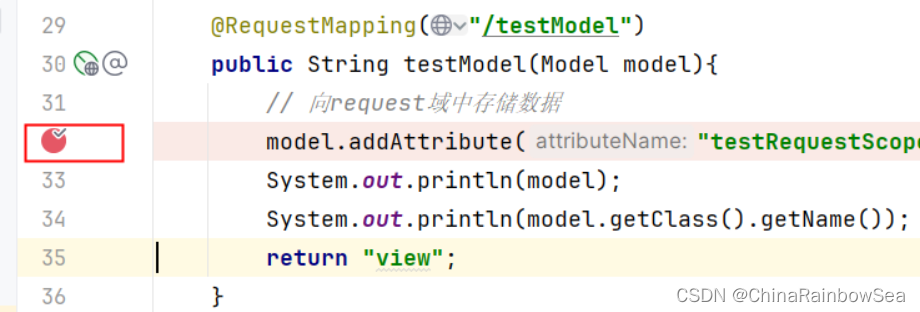
启动服务器,发送请求,走到断点:
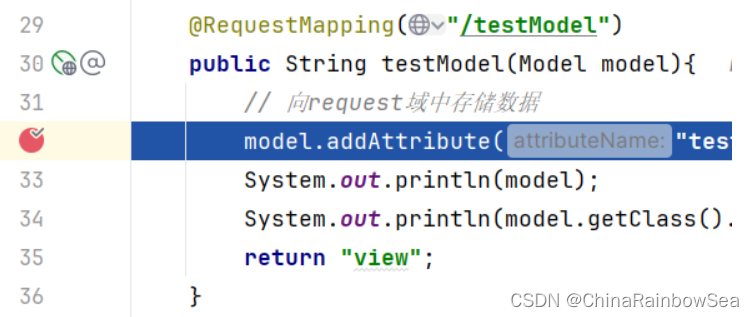
查看VM Stack信息:
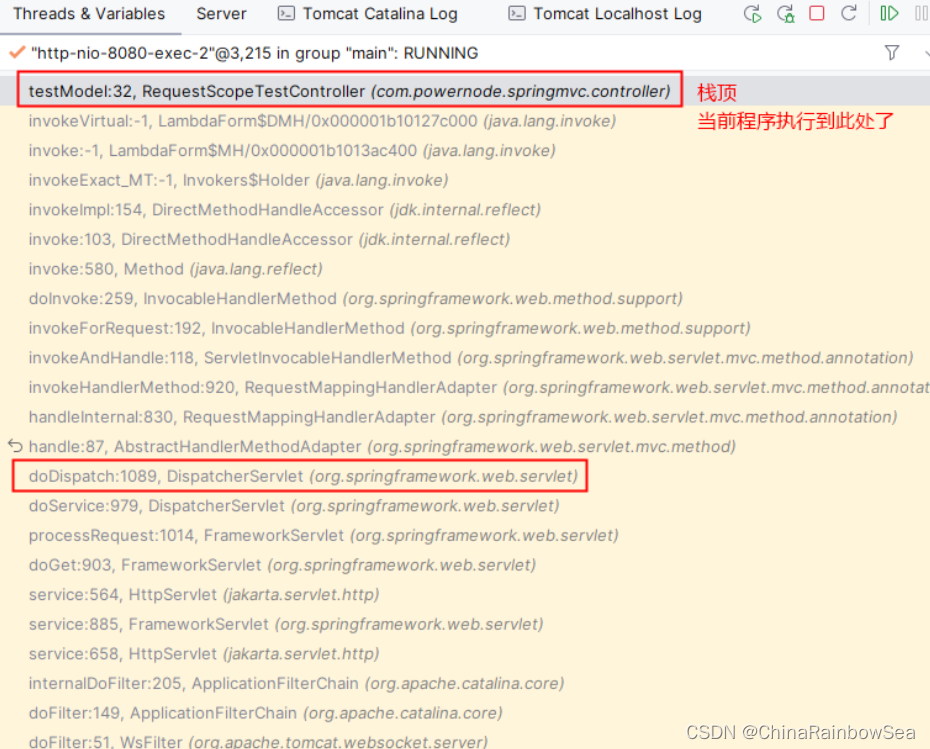
查看 DispatcherServlet 的1089行,源码如下:

可以看到这里,无论你使用哪种方式,最终都要返回一个ModelAndView对象。
对于
mv = ha.handle(processedRequest, response, mappedHandler.getHandler());处理器方法来说,不管你使用的参数是 Model接口,还是Map接口,还是ModelMap类,还是ModelAndView类,最终处理器方法执行结束之前
返回的都是 ModelAndView对象,这个返回的ModelAndView对象给DispatcherServlet类了
当请求路径不是JSP的时候,都会走前端控制器 DispatcherServlet
DispatcherServlet 中有一个核心方法 doDispatch(),这个方法用来通过请求路径找到对应的处理器方法
然后调用处理器方法,处理器方法返回一个逻辑视图名称(可能也会直接返回一个ModelAndView对象)
,返回给DispatcherServlet
提醒:大家可以通过以下断点调试方式,采用一级一级返回,最终可以看到都会返回ModelAndView对象。

5. Spring MVC 获取 session 会话域对象的二种方式
在SpringMVC中使用session域共享数据,实现方式有多种,其中比较常见的两种方式:
- 使用原生Servlet API
- 使用SessionAttributes注解
5.1 第一种方式:使用原生Servlet API 获取到 session 会话域,同时获取到 session 会话域当中的信息
使用原生Servlet API ,就是将 HttpSession 作为方法的参数形式,Spring MVC 会自动获取到 Tomcat 服务器当中的 HttpSession 对象,赋值到这个方法的对应的 HttpSession 参数上。
创建:SessionScopeTestController 类

import jakarta.servlet.http.HttpSession;
import org.springframework.stereotype.Controller;
import org.springframework.ui.ModelMap;
import org.springframework.web.bind.annotation.RequestMapping;
import org.springframework.web.bind.annotation.SessionAttributes;
@Controller // 交给 Spring IOC 容器管理
public class SessionScopeTestController {
@RequestMapping("/testSessionServletAPI")
public String testServletAPI(HttpSession session) {
// 处理核心业务...
//将数据存储到 Session中
session.setAttribute("testSessionScope","在Spring MVC 当中使用原生 Servlet API 完成 session 域数据共享");
// 返回逻辑视图(这是一个转发的行为)
return "ok";
}
}
index 页面超链接的编写:
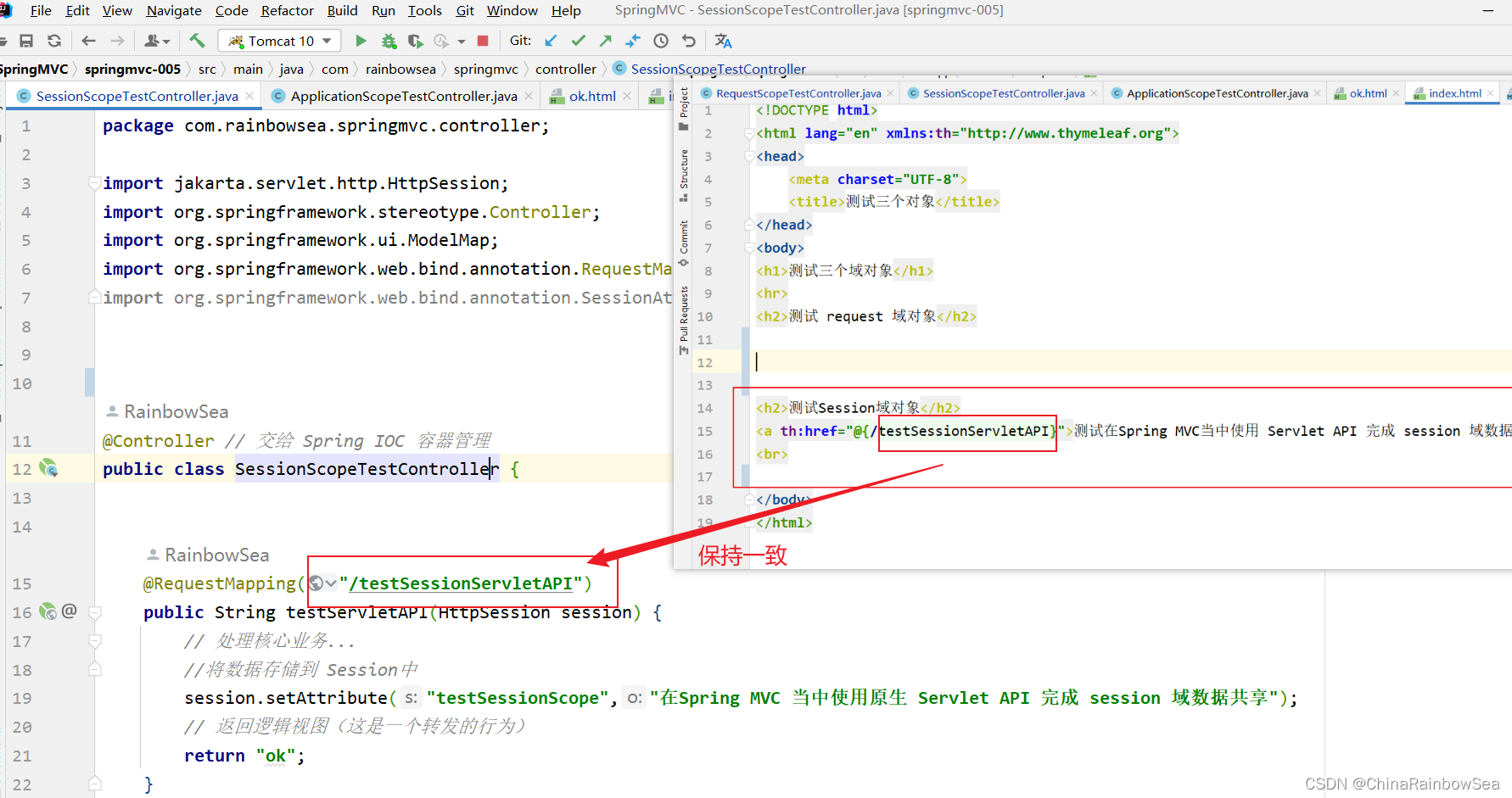
ok 页面获取 request 请求域的展示的编写
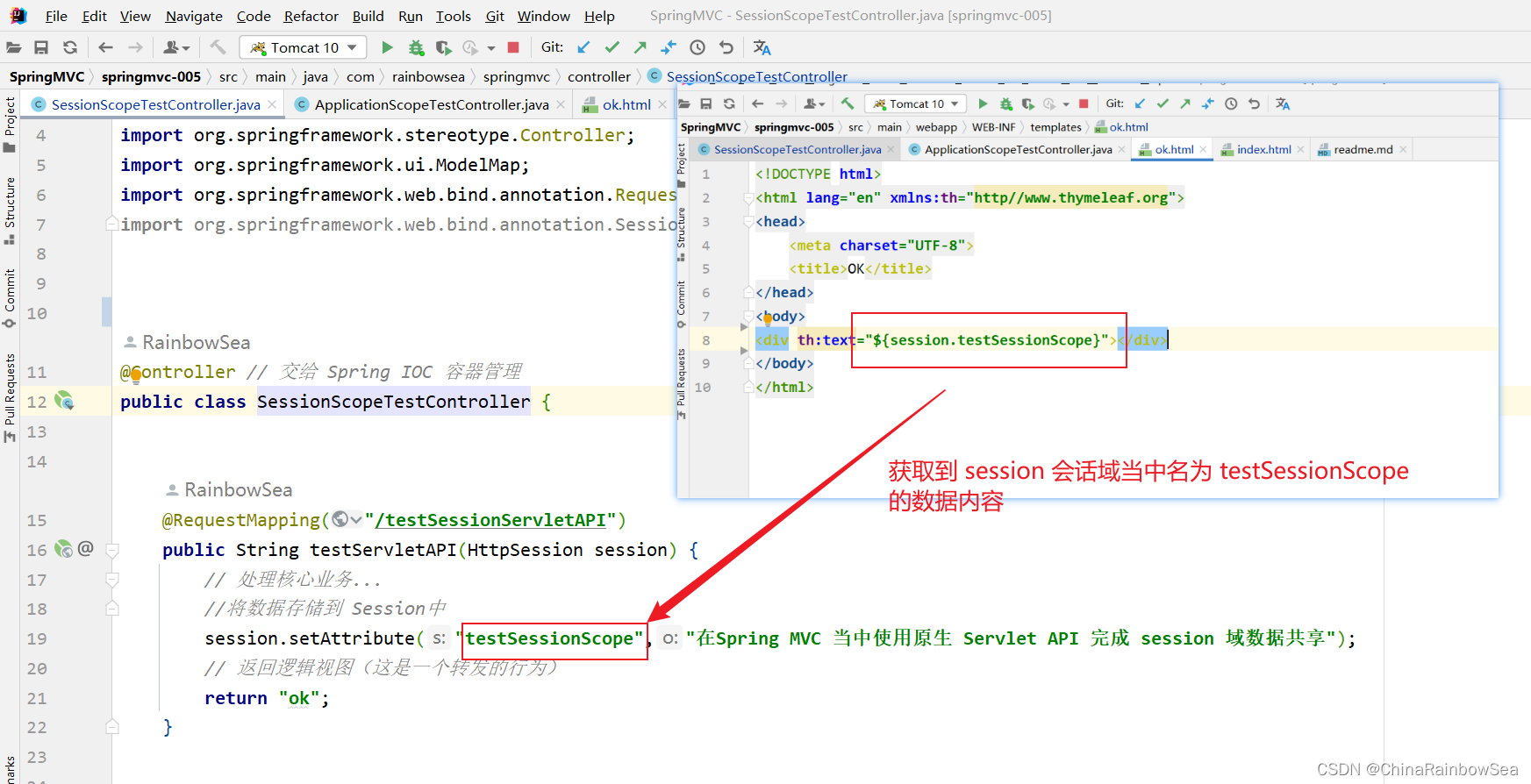
html>
<html lang="en" xmlns:th="http//www.thymeleaf.org">
<head>
<meta charset="UTF-8">
<title>OKtitle>
head>
<body>
<div th:text="${session.testSessionScope}">div>
body>
html>
启动 Tomcat 服务器测试结果:
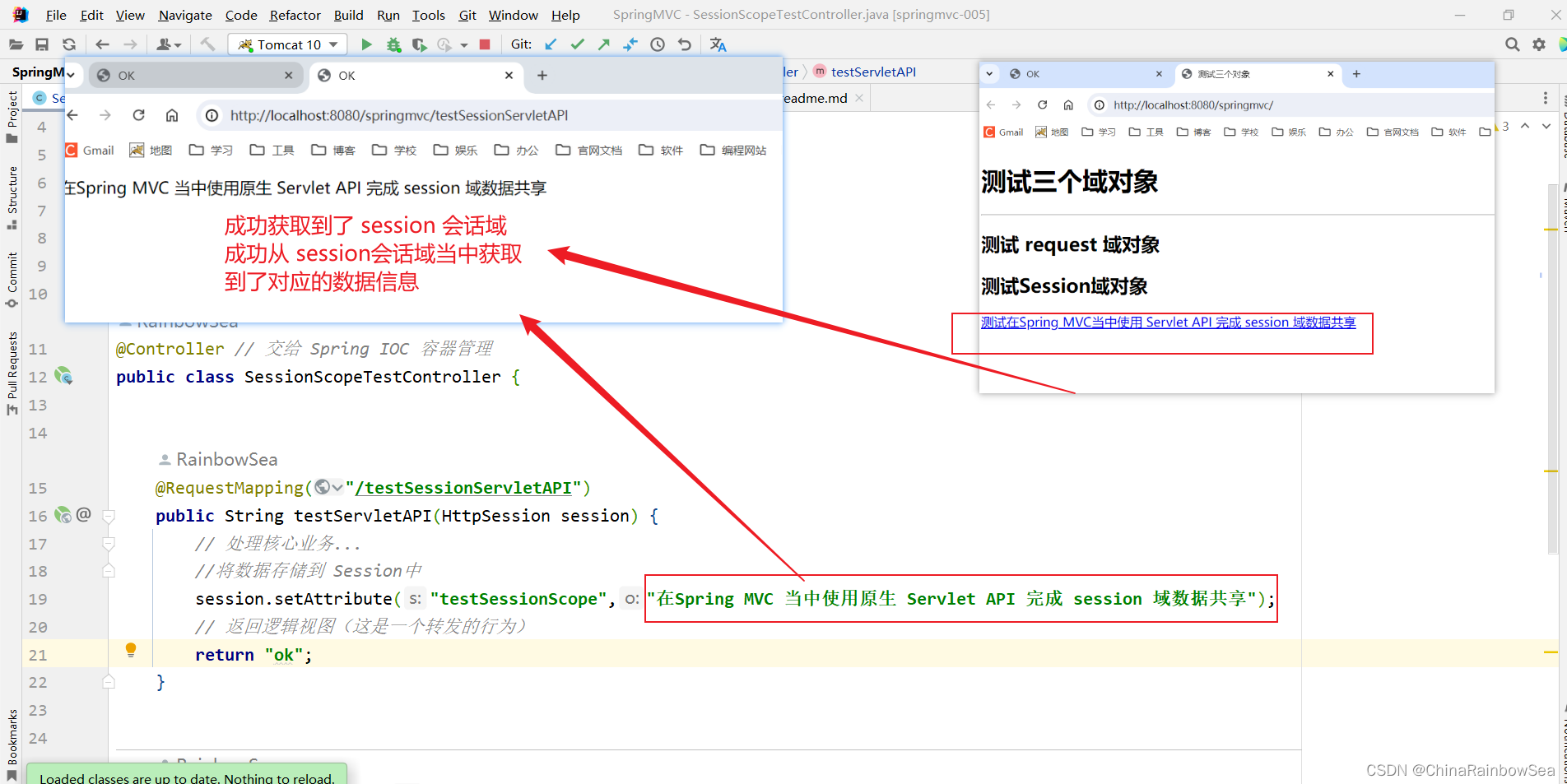
5.2 第二种方式:使用 @SessionAttributes 注解 获取到 session 会话域,同时获取到 session 会话域当中的信息
使用 @SessionAttributes 注解标注 Controller:
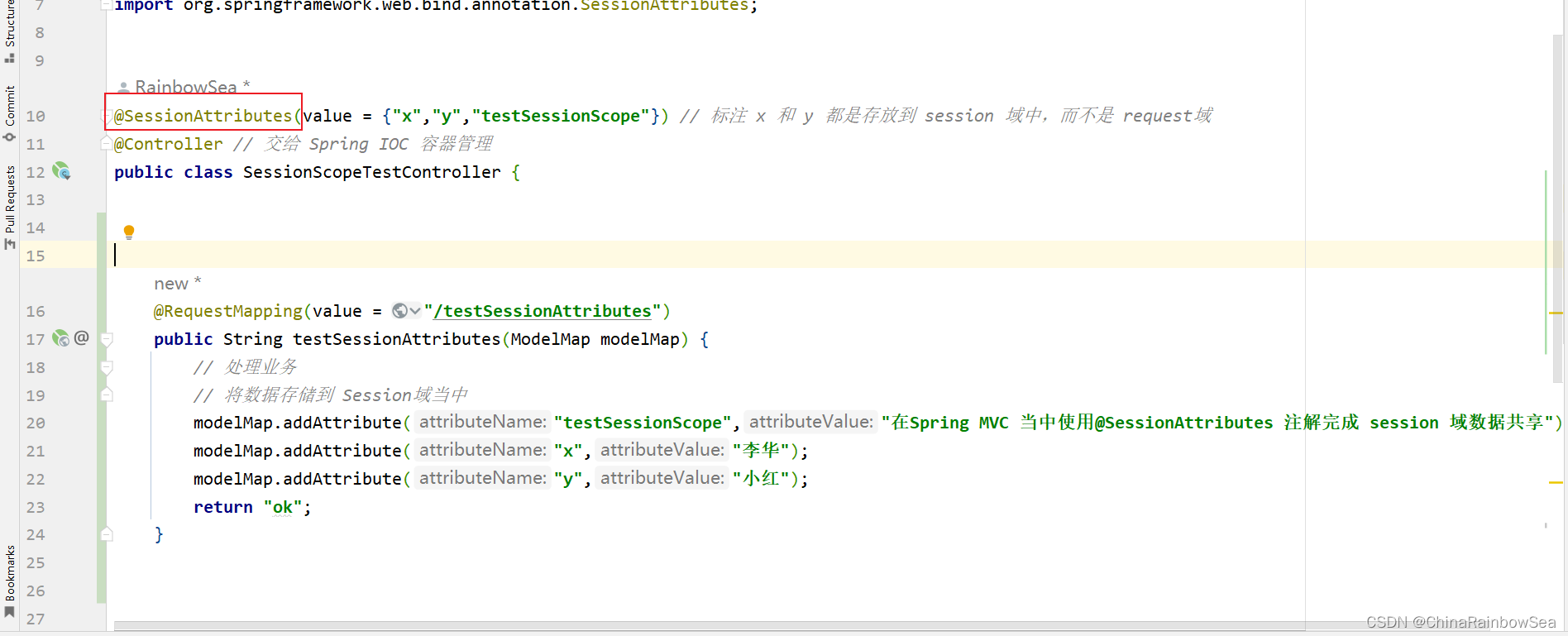
@SessionAttributes(value = {"x","y","testSessionScope"}) // 标注 x 和 y 都是存放到 session 域中,而不是 request域
**注意:@SessionAttributes 注解使用在Controller类上。标注了当 key是 x 或者 y 时,该(x 或 y)的数据将被存储到会话 session域当中中。而如果没有 SessionAttributes注解,默认存储到 request域中。 **
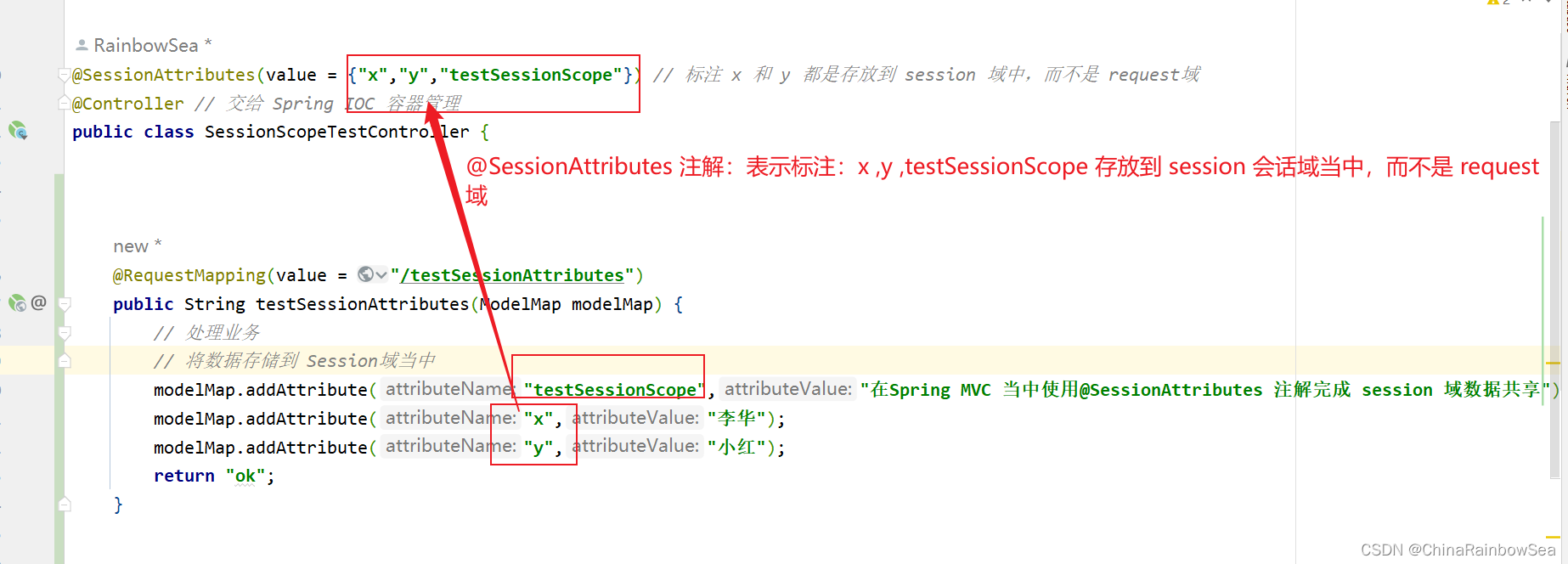
import jakarta.servlet.http.HttpSession;
import org.springframework.stereotype.Controller;
import org.springframework.ui.ModelMap;
import org.springframework.web.bind.annotation.RequestMapping;
import org.springframework.web.bind.annotation.SessionAttributes;
@SessionAttributes(value = {"x","y","testSessionScope"}) // 标注 x 和 y 都是存放到 session 域中,而不是 request域
@Controller // 交给 Spring IOC 容器管理
public class SessionScopeTestController {
@RequestMapping(value = "/testSessionAttributes")
public String testSessionAttributes(ModelMap modelMap) {
// 处理业务
// 将数据存储到 Session域当中
modelMap.addAttribute("testSessionScope","在Spring MVC 当中使用@SessionAttributes 注解完成 session 域数据共享");
modelMap.addAttribute("x","李华");
modelMap.addAttribute("y","小红");
return "ok";
}
}
index 页面超链接的编写:
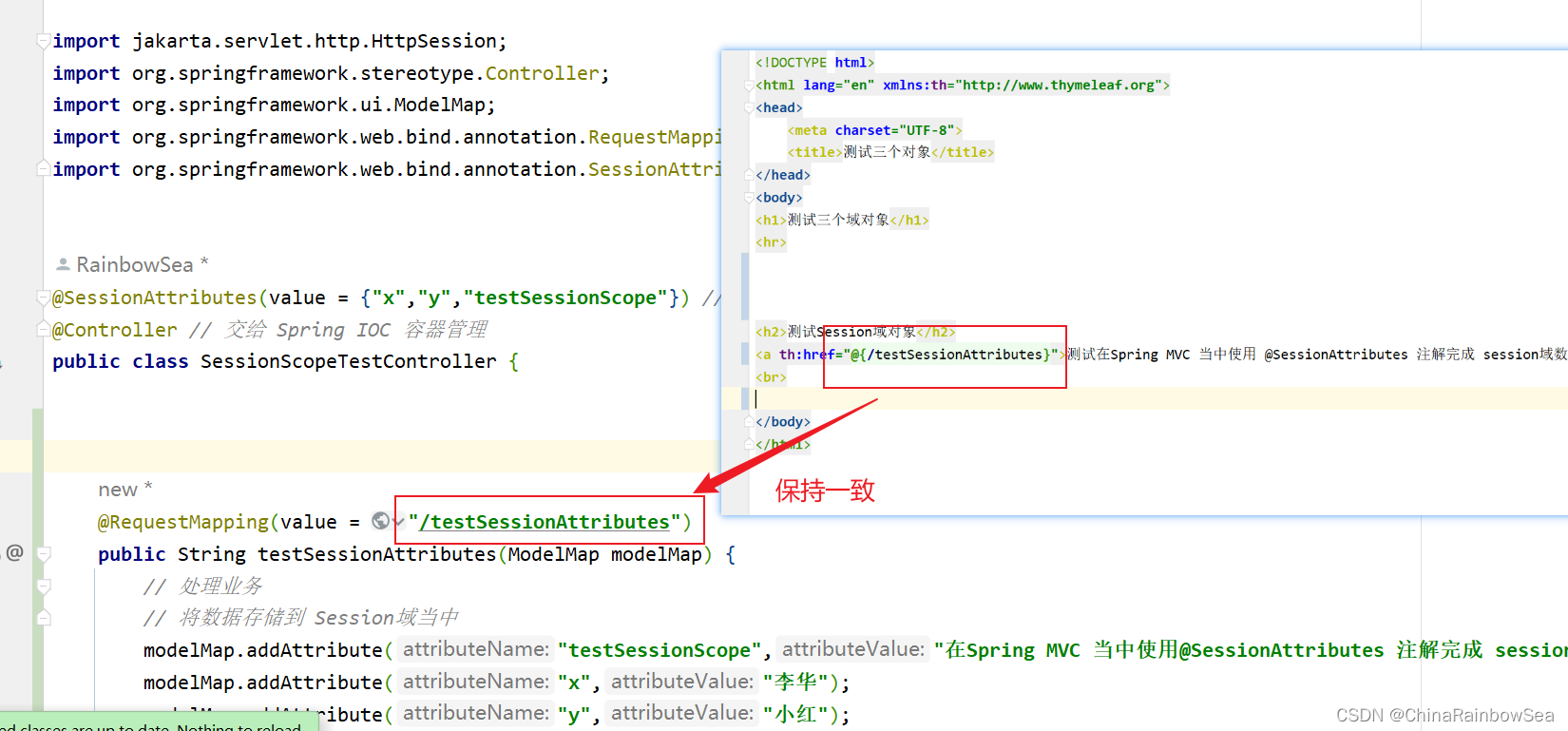
html>
<html lang="en" xmlns:th="http://www.thymeleaf.org">
<head>
<meta charset="UTF-8">
<title>测试三个对象title>
head>
<body>
<h1>测试三个域对象h1>
<hr>
<h2>测试Session域对象h2>
<a th:href="@{/testSessionAttributes}">测试在Spring MVC 当中使用 @SessionAttributes 注解完成 session域数据共享a>
<br>
body>
html>
ok 页面获取 request 请求域的展示的编写:
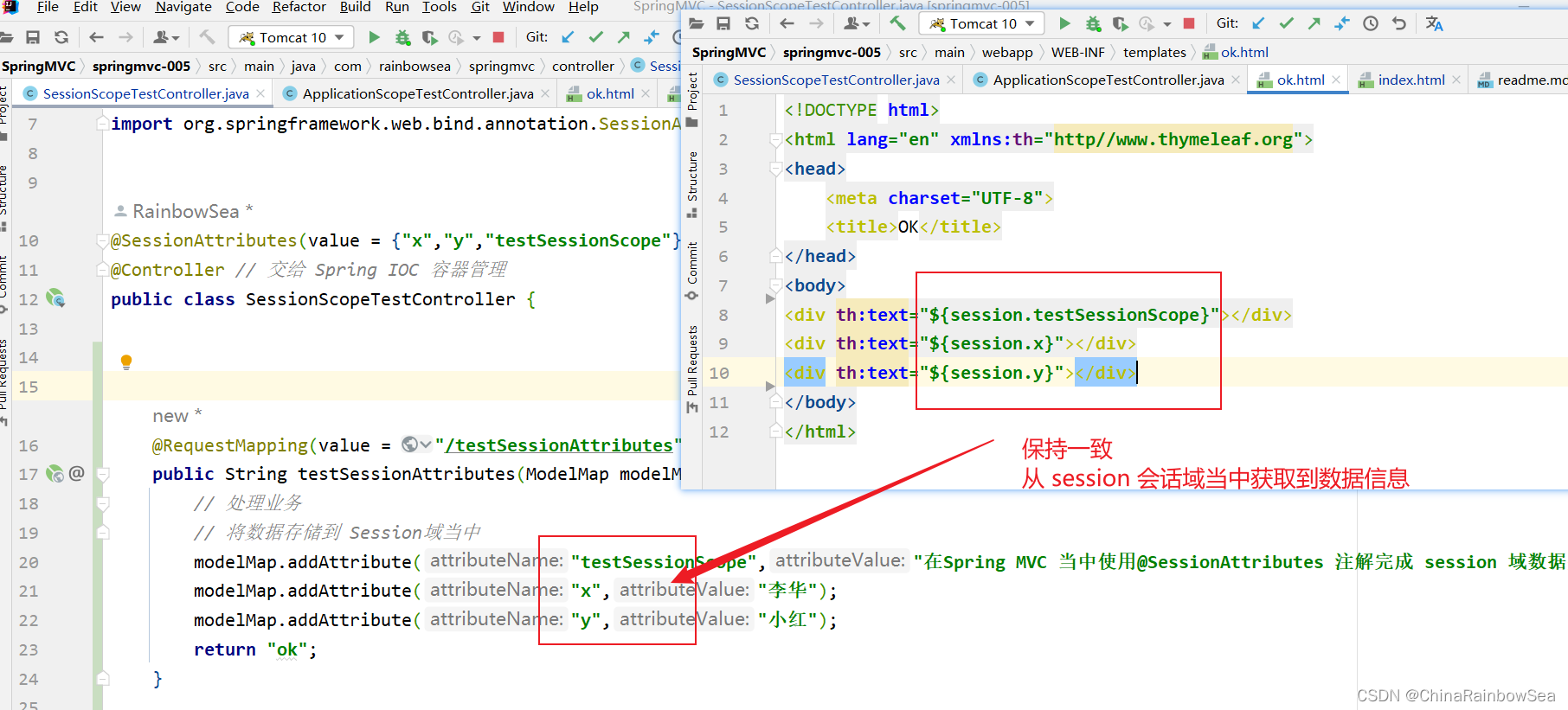
html>
<html lang="en" xmlns:th="http//www.thymeleaf.org">
<head>
<meta charset="UTF-8">
<title>OKtitle>
head>
<body>
<div th:text="${session.testSessionScope}">div>
<div th:text="${session.x}">div>
<div th:text="${session.y}">div>
body>
html>
启动 Tomcat 服务器测试结果:
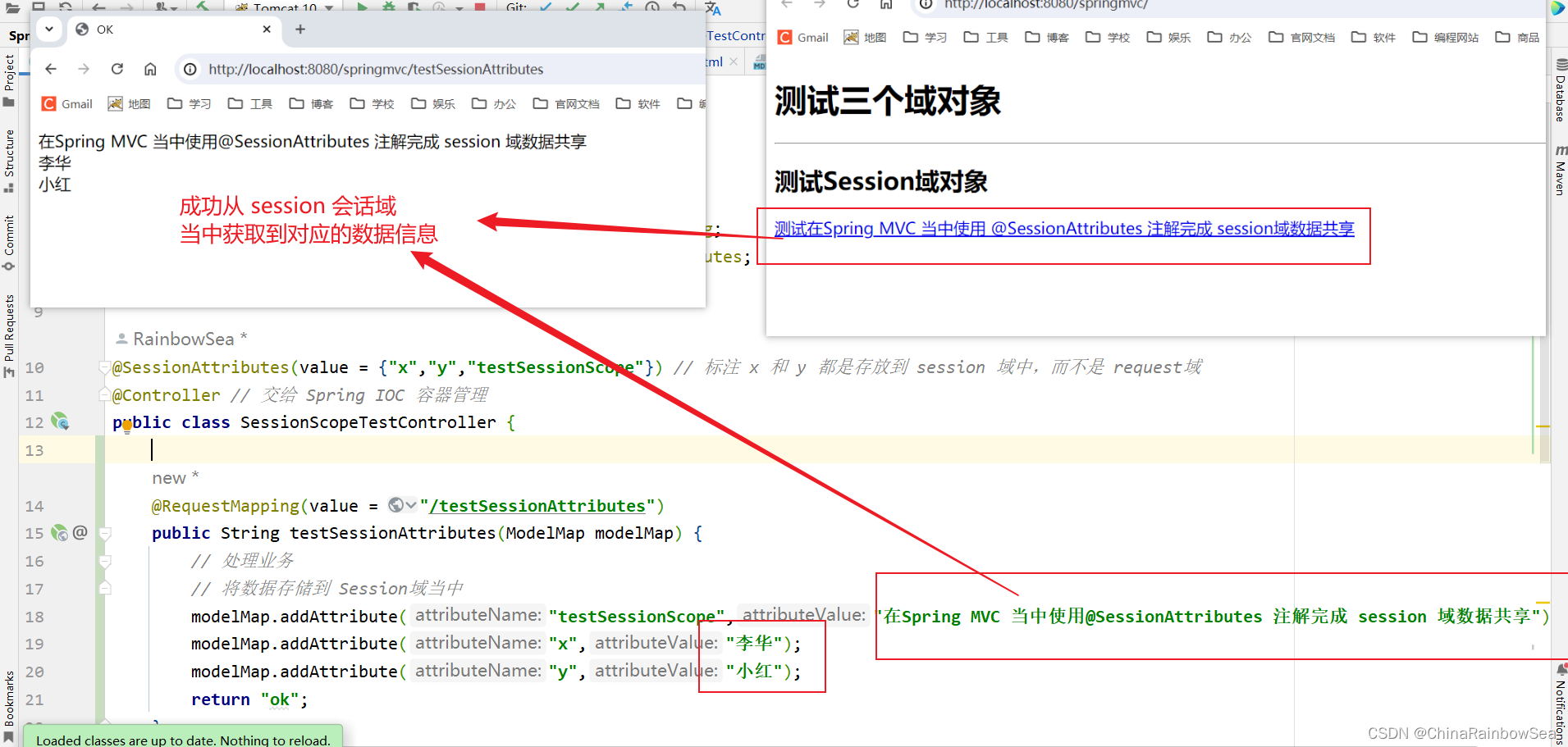
6. Spring MVC 获取 application 应用域对象的方式
在SpringMVC实现application域数据共享,最常见的方案就是直接使用Servlet API了:
这个 application 域使用较少,如果使用的话,一般是采用 ServletAPI的方式使用
创建:ApplicationScopeTestController 类
将 HttpServletRequest 作为参数,定义到方法上,Spring MVC 框架会自动从 Tomcat 服务器当中获取到这个 HttpServletRequest 对象的值,然后,传递给这个方法的 HttpServletRequest 参数值上,完成赋值。
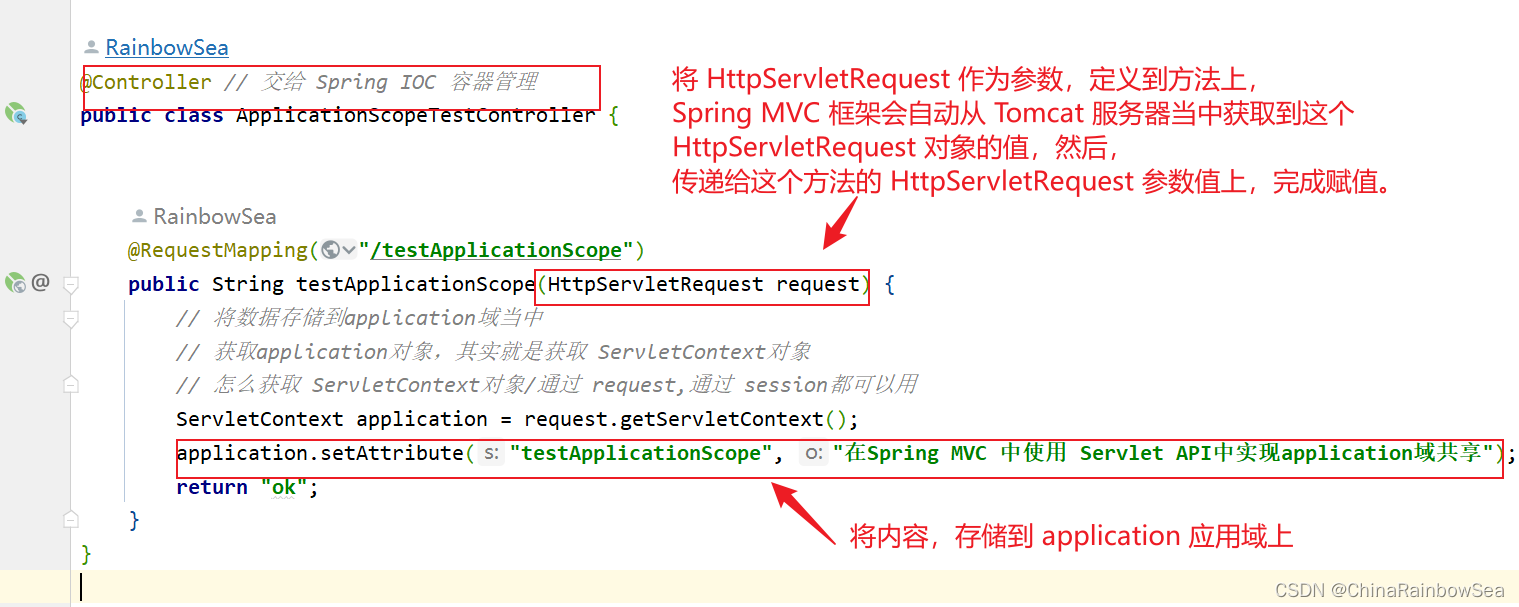
package com.rainbowsea.springmvc.controller;
import jakarta.servlet.ServletContext;
import jakarta.servlet.http.HttpServletRequest;
import org.springframework.stereotype.Controller;
import org.springframework.web.bind.annotation.RequestMapping;
@Controller // 交给 Spring IOC 容器管理
public class ApplicationScopeTestController {
@RequestMapping("/testApplicationScope")
public String testApplicationScope(HttpServletRequest request) {
// 将数据存储到application域当中
// 获取application对象,其实就是获取 ServletContext对象
// 怎么获取 ServletContext对象/通过 request,通过 session都可以用
ServletContext application = request.getServletContext();
application.setAttribute("testApplicationScope", "在Spring MVC 中使用 Servlet API中实现application域共享");
return "ok";
}
}
index 页面超链接的编写:
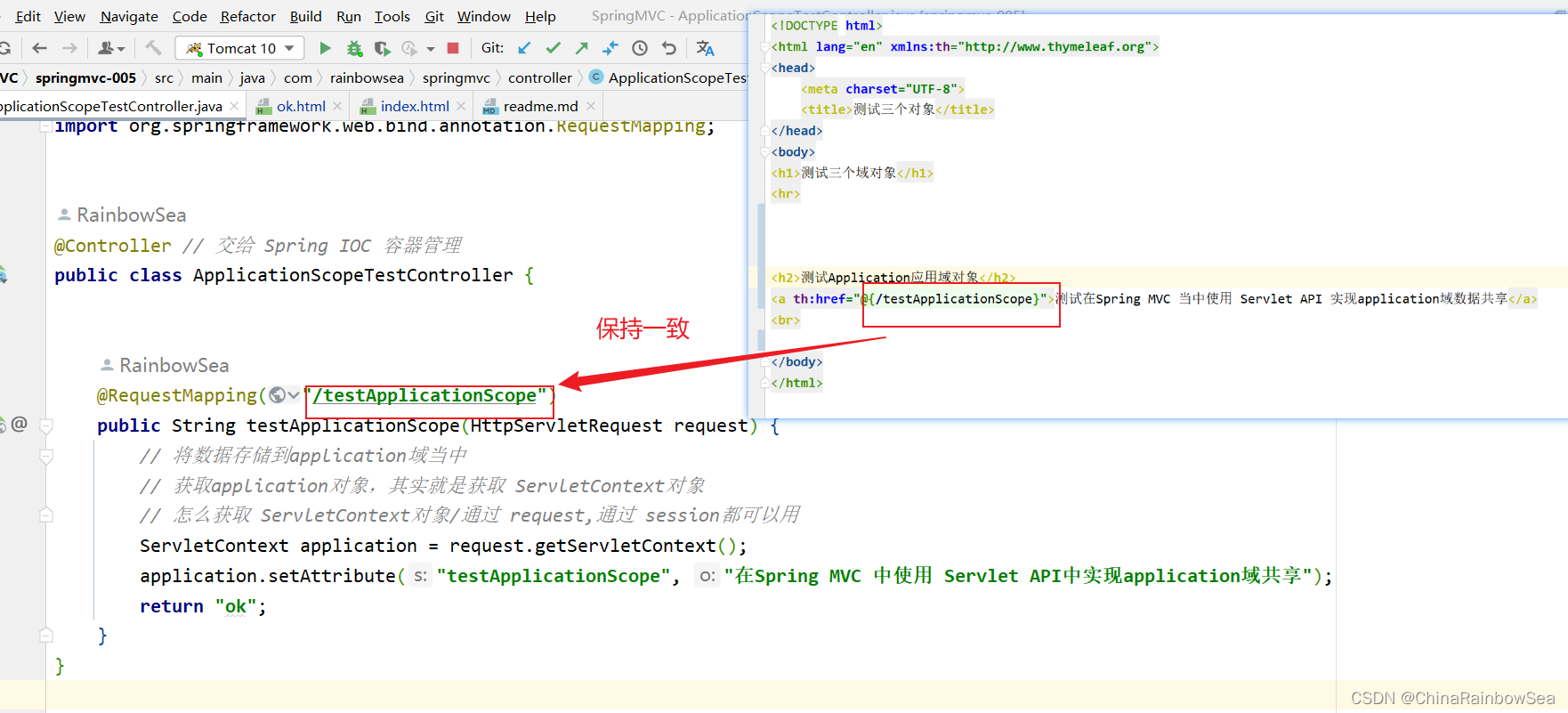
html>
<html lang="en" xmlns:th="http://www.thymeleaf.org">
<head>
<meta charset="UTF-8">
<title>测试三个对象title>
head>
<body>
<h1>测试三个域对象h1>
<hr>
<h2>测试Application应用域对象h2>
<a th:href="@{/testApplicationScope}">测试在Spring MVC 当中使用 Servlet API 实现application域数据共享a>
<br>
body>
html>
ok 页面获取 request 请求域的展示的编写
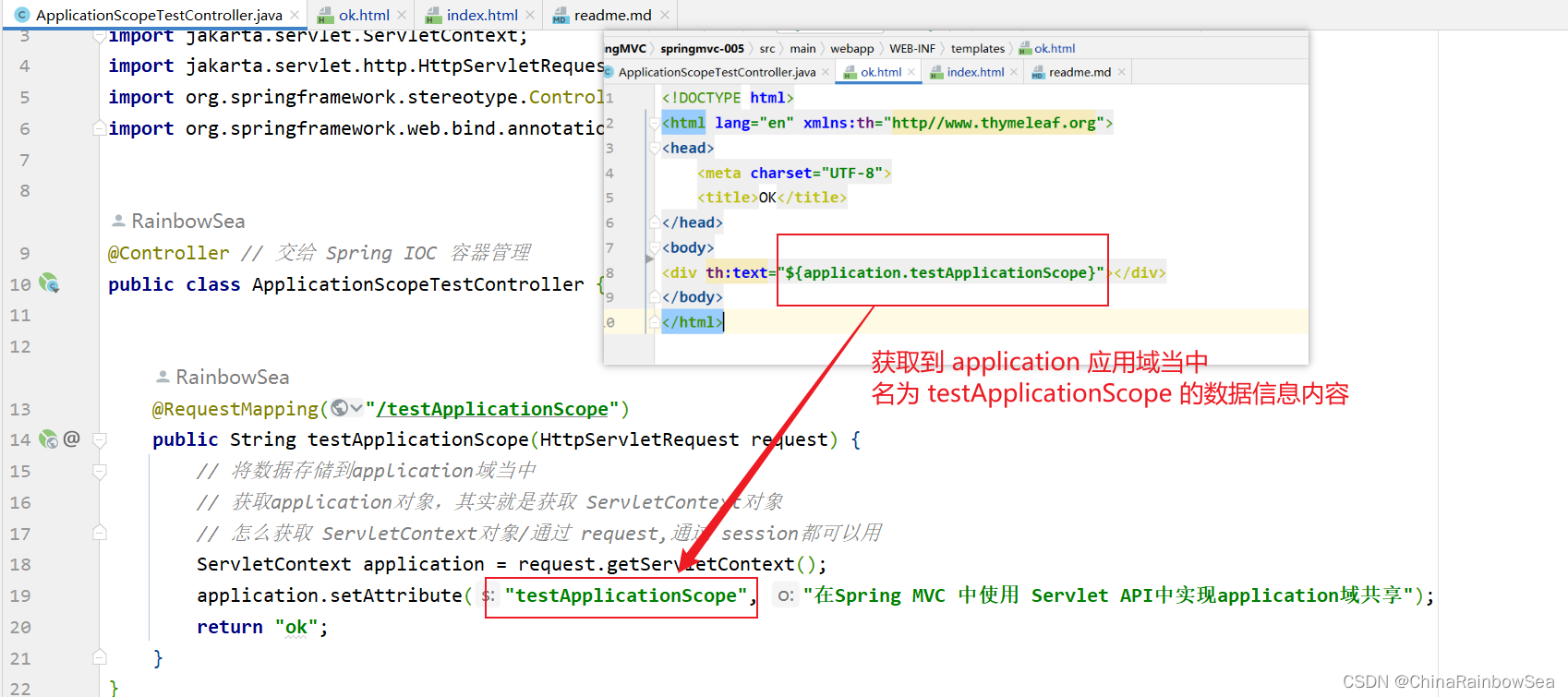
启动 Tomcat 服务器测试结果:
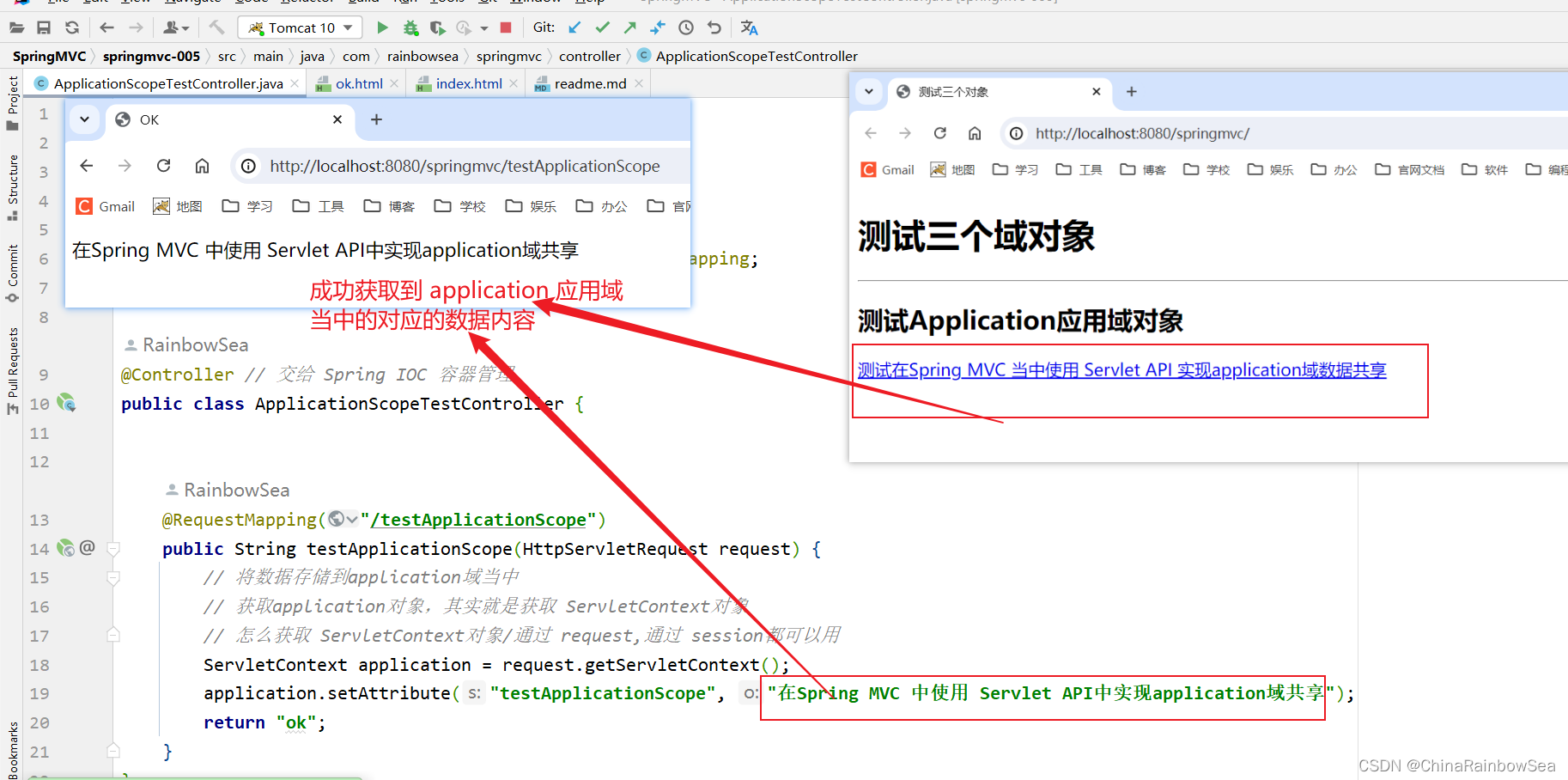
7. 总结:
三个域:request 请求域,session 会话域,application 应用域
三者域的使用,从最小范围的域,来判断使用,可以用范围更小的域,就用范围更小的域来解决问题,传数据资源。如果域的范围不够,就一点的扩大。
在SpringMVC中,在request域中共享数据有以下五种方式:
- 使用原生Servlet API方式。
- 使用Model接口。
- 使用Map接口。
- 使用ModelMap类。
- 使用ModelAndView类。
在SpringMVC中使用session域共享数据,实现方式有多种,其中比较常见的两种方式:
- 使用原生Servlet API
- 使用SessionAttributes注解
Spring MVC 获取 application 应用域对象的方式
8. 最后:
“在这个最后的篇章中,我要表达我对每一位读者的感激之情。你们的关注和回复是我创作的动力源泉,我从你们身上吸取了无尽的灵感与勇气。我会将你们的鼓励留在心底,继续在其他的领域奋斗。感谢你们,我们总会在某个时刻再次相遇。”
